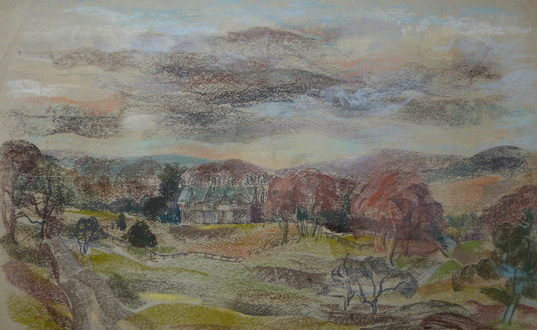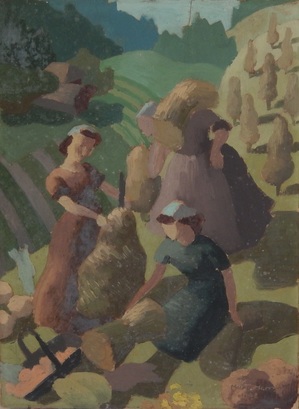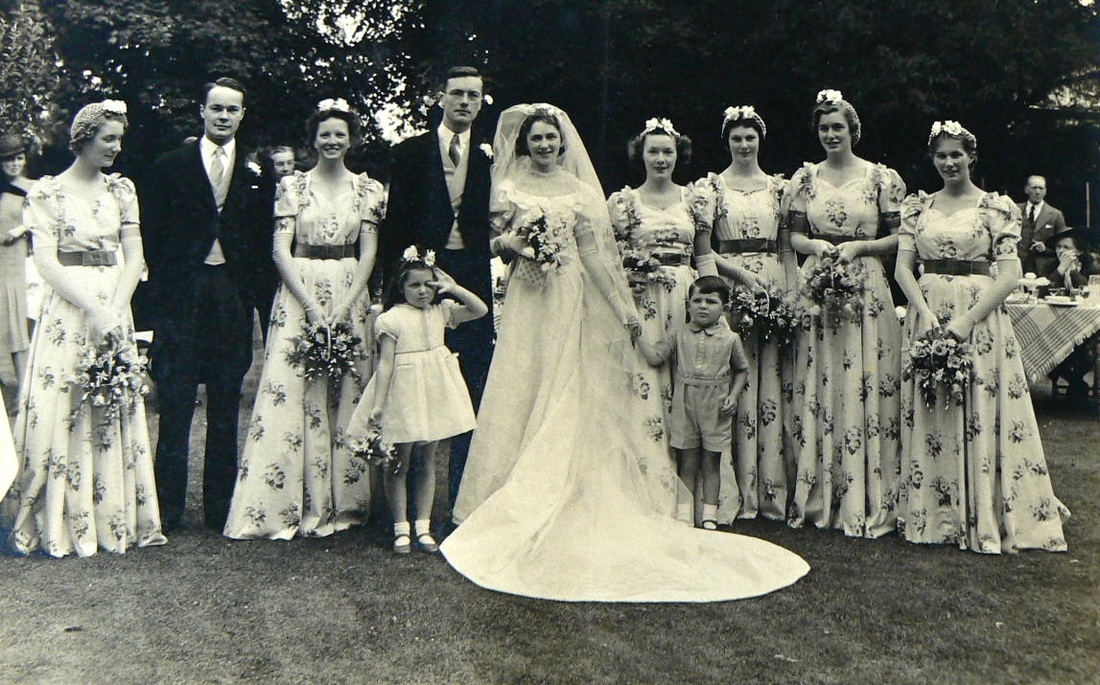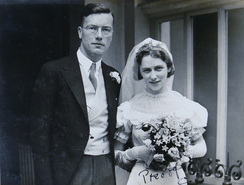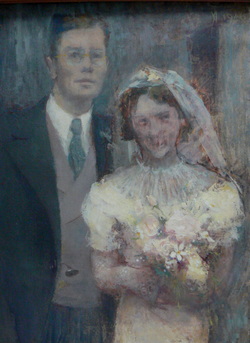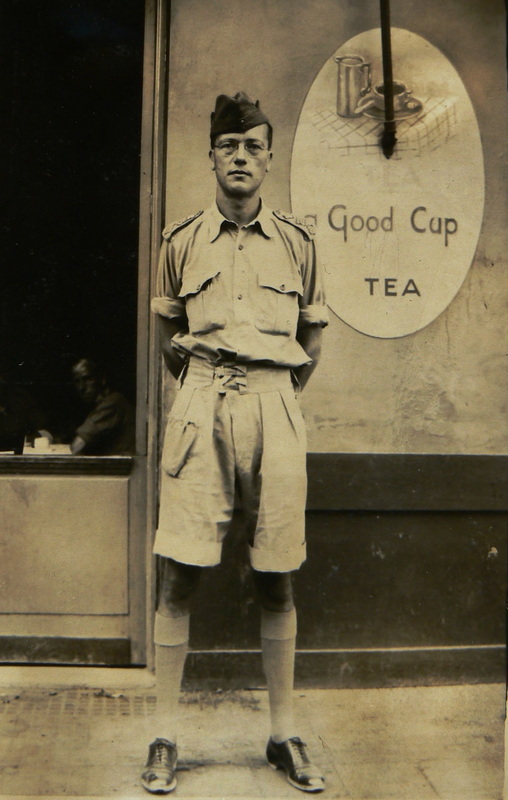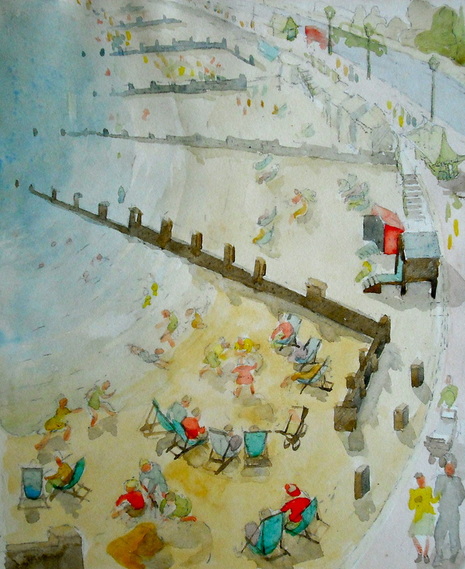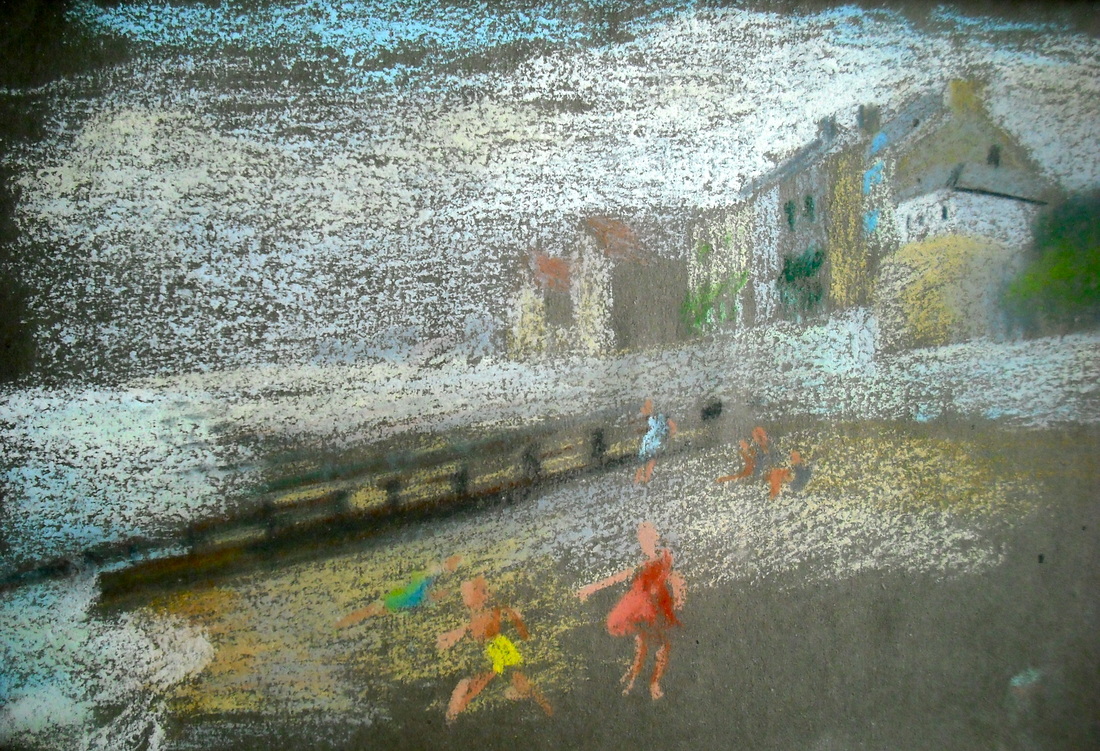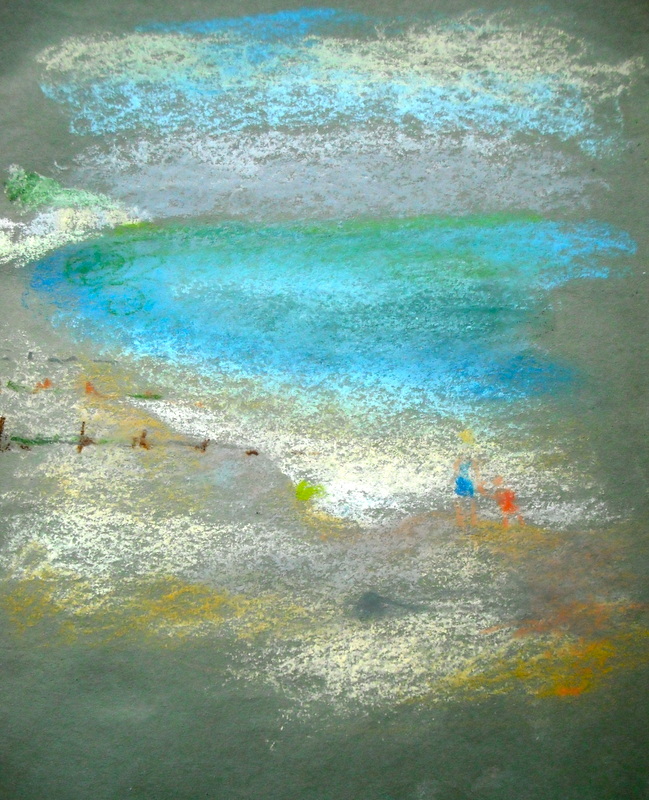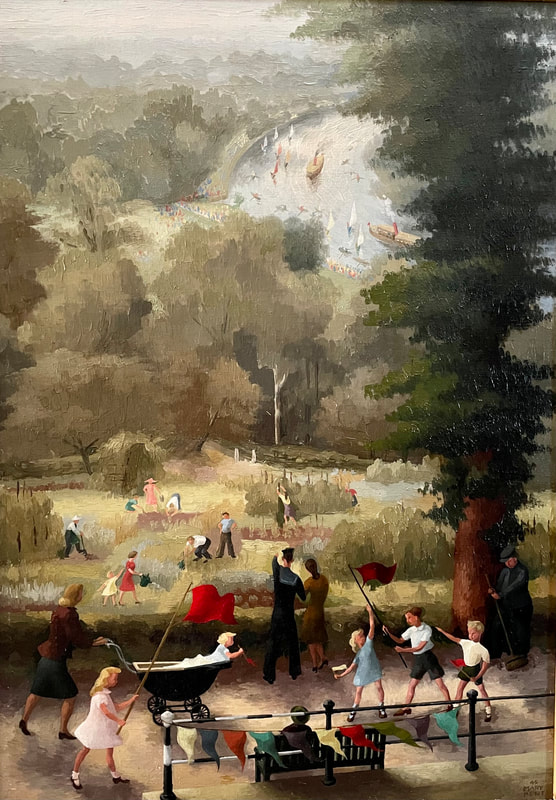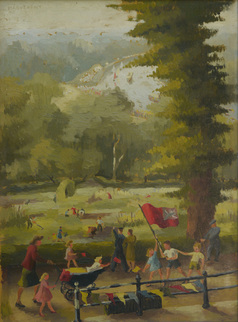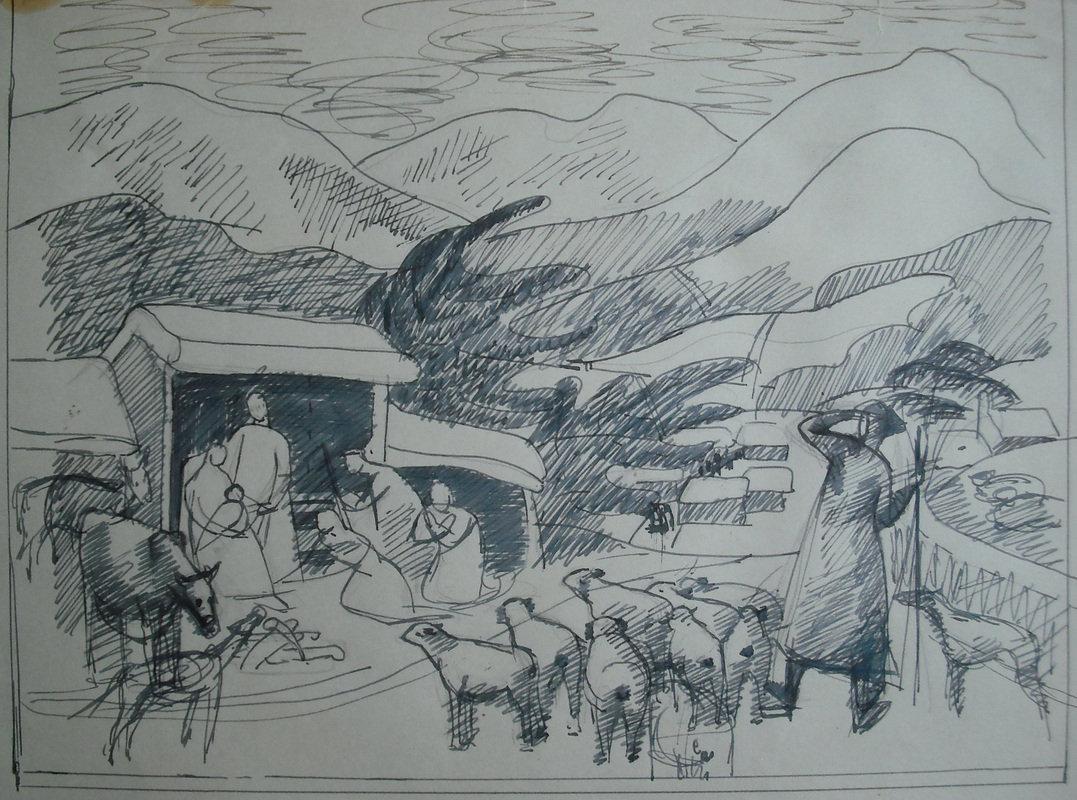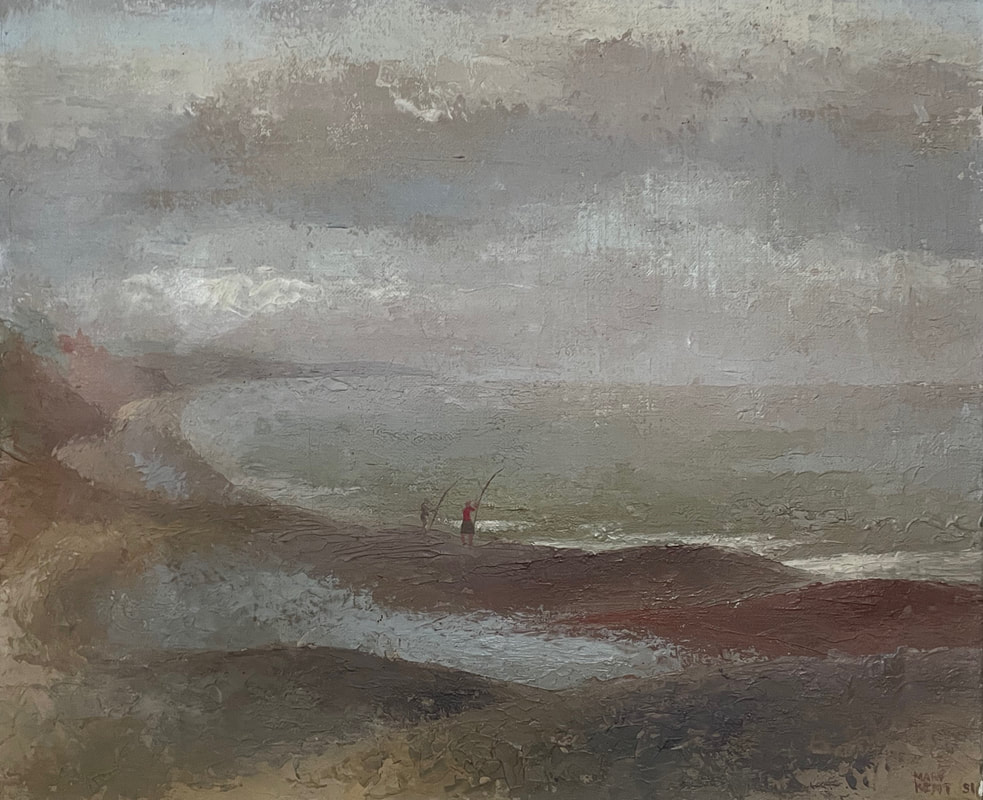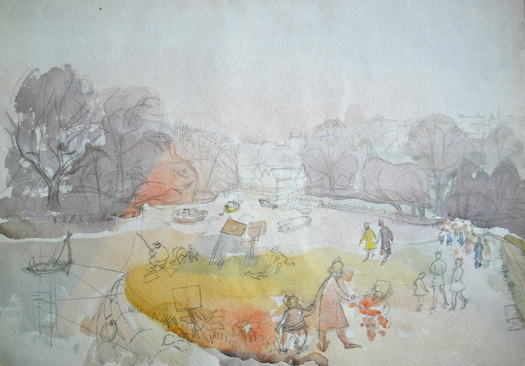Harvest In Hungary - 1938
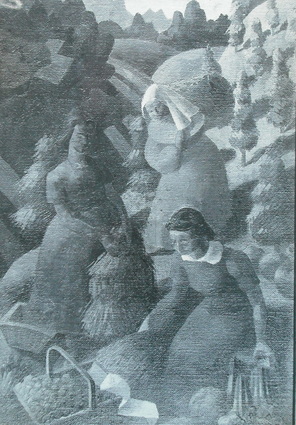
Exhibited :
Brook Street Galleries - 1940
Brook Street Galleries - 1940
Preparatory drawing for 'Harvest in Hungary" - 1938
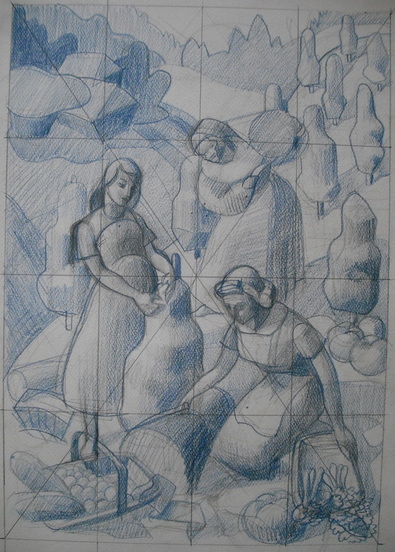
My Neighbour's Garden - 1938
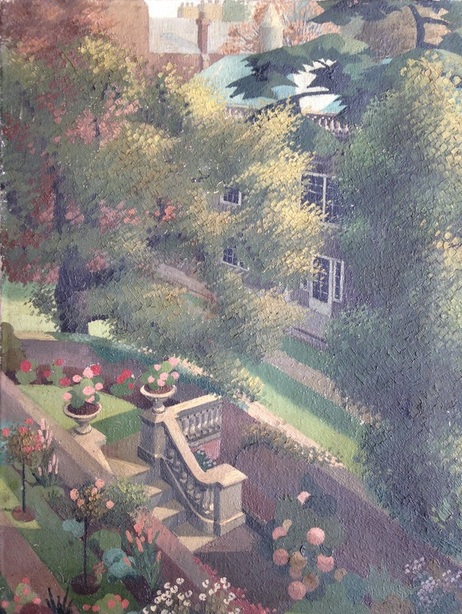
Exhibited :
Brook Street Galleries - 1940
R.B.A. 1953 - (where it was titled 'The Garden Next Door')
Apologies for the very blurry image.
Brook Street Galleries - 1940
R.B.A. 1953 - (where it was titled 'The Garden Next Door')
Apologies for the very blurry image.
The marriage of Mary Marryat and George Kent Harrison. August 1939, Richmond, Surrey, London. The marriage ceremony took place at St Matthias Church, Richmond, Surrey.
Standing on Kent's right hand side is the artist Margaret Thomas who became a lifelong friend and confidant of MKH. They met at Art College and exhibited together from then onwards throughout their careers, especially at The Royal Academy, The RBA, The NEAC, and The Royal Scottish academy. Their painting style was very different, although their subject matter was often very similar.
The marriage took place only a matter of weeks before the outbreak of World War Two. Three years after this photograph was taken Mary was working for Royal Ordinance Survey making military maps, and Kent would be very far away from her and in command of a forward surgical unit at the Second Battle Of El Alamein, Egypt.
Standing on Kent's right hand side is the artist Margaret Thomas who became a lifelong friend and confidant of MKH. They met at Art College and exhibited together from then onwards throughout their careers, especially at The Royal Academy, The RBA, The NEAC, and The Royal Scottish academy. Their painting style was very different, although their subject matter was often very similar.
The marriage took place only a matter of weeks before the outbreak of World War Two. Three years after this photograph was taken Mary was working for Royal Ordinance Survey making military maps, and Kent would be very far away from her and in command of a forward surgical unit at the Second Battle Of El Alamein, Egypt.
The marriage of Mary Marryat and George Kent Harrison painted by Margaret Thomas.
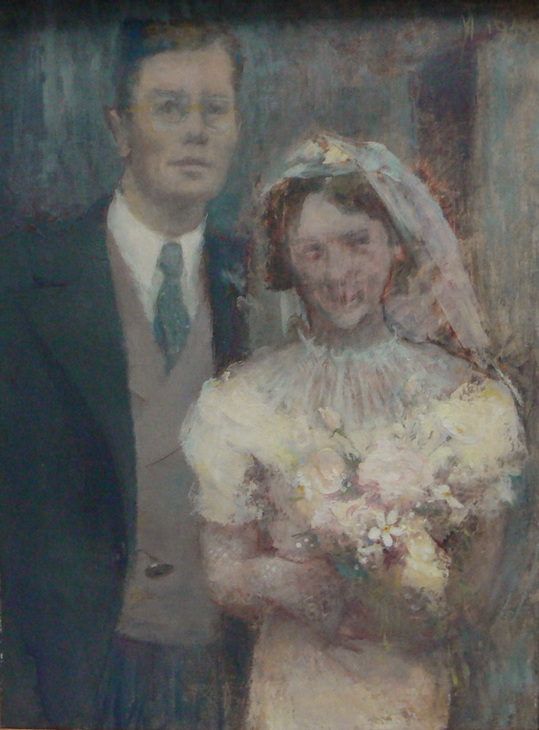
The marriage of Mary Marryat and George Kent Harrison painted by Margaret Thomas, RBA, RWA, NEAC
The marriage of Mary Marryat and George Kent Harrison - 1939 - Richmond - London
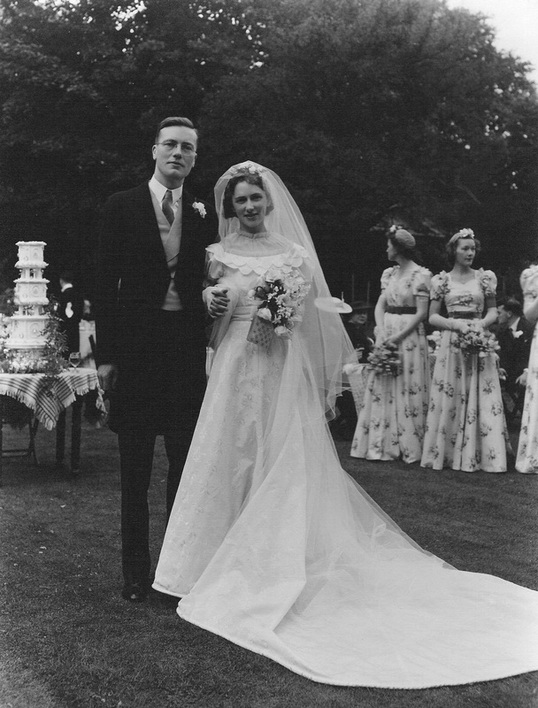
The marriage ceremony took place in St Mathias Church in Richmond, London, in 1939.
MKH was brought up in Richmond in a wonderful house on The Terrace with views looking west over The Thames. She made many paintings of the river and several of Richmond Park.
When death parted them in 1983, it was at the same church (St Matthias Church) in Richmond that Mary Kent Harrison's funeral took place, and it is yet more remarkable that the funeral service was conducted by the same minister, the Reverend G.H.M. Gray, who married them.
Kent lived on for a further five years. He moved south to Lymington where new friends and the glow from his own much respected career as a surgeon, and the self respect earned from the dedication and work he put into that career may have gone some way to balance the bereavement. He once put coping with the loss rather well when he said - 'I am alright as long as I don't stop to think".
Mary's paintings were on every wall of the new house.
MKH was brought up in Richmond in a wonderful house on The Terrace with views looking west over The Thames. She made many paintings of the river and several of Richmond Park.
When death parted them in 1983, it was at the same church (St Matthias Church) in Richmond that Mary Kent Harrison's funeral took place, and it is yet more remarkable that the funeral service was conducted by the same minister, the Reverend G.H.M. Gray, who married them.
Kent lived on for a further five years. He moved south to Lymington where new friends and the glow from his own much respected career as a surgeon, and the self respect earned from the dedication and work he put into that career may have gone some way to balance the bereavement. He once put coping with the loss rather well when he said - 'I am alright as long as I don't stop to think".
Mary's paintings were on every wall of the new house.
Down The Hill - 1939
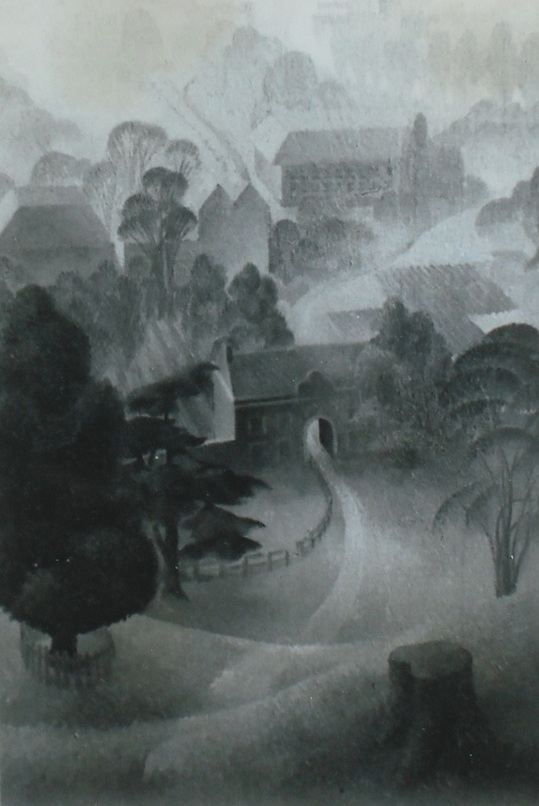
Exhibited :
Brook Street galleries - 1940
Brook Street galleries - 1940
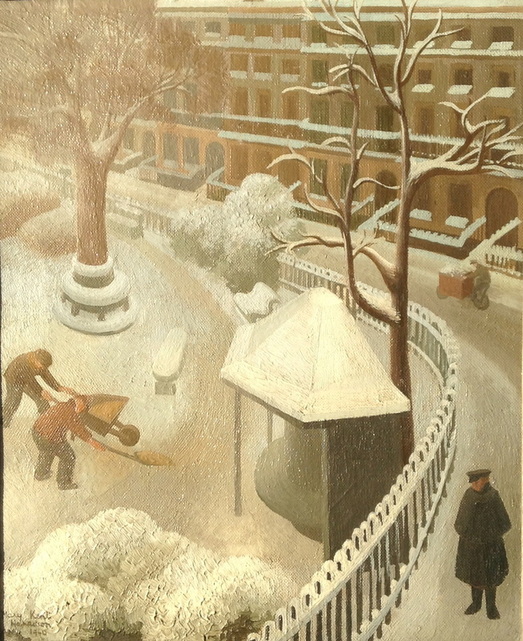 Mary Kent Harrison - Snow On The Square (Large version) - 1940 - Exhibited : The Royal Academy 1941
Mary Kent Harrison - Snow On The Square (Large version) - 1940 - Exhibited : The Royal Academy 1941
Cotswold Landscape - 1939
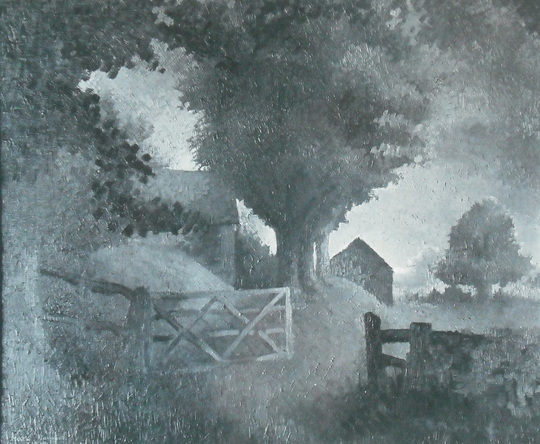
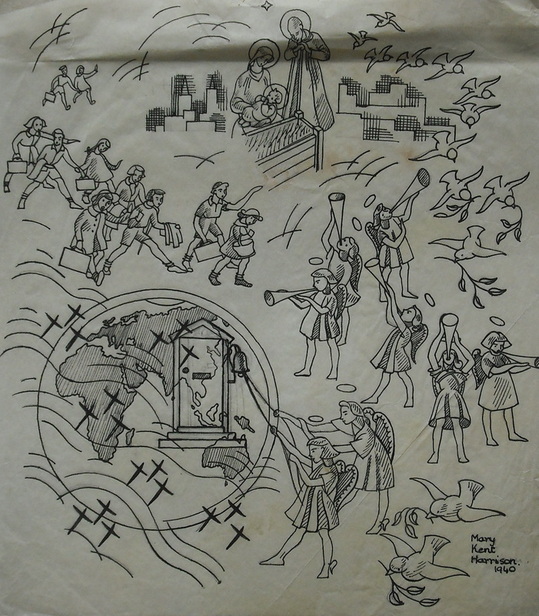
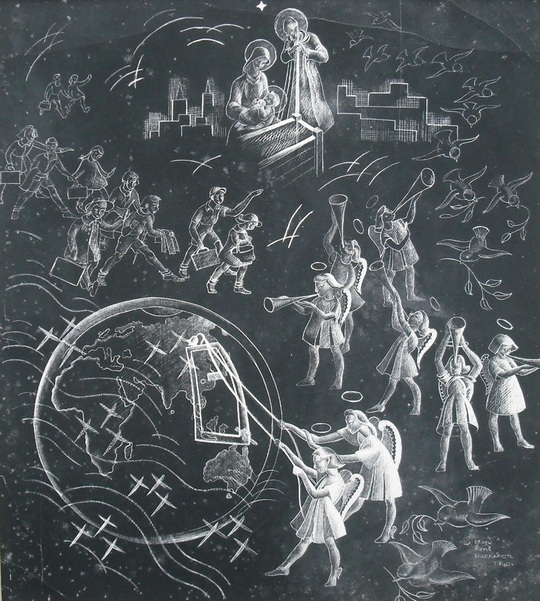
By Banchory - 1940
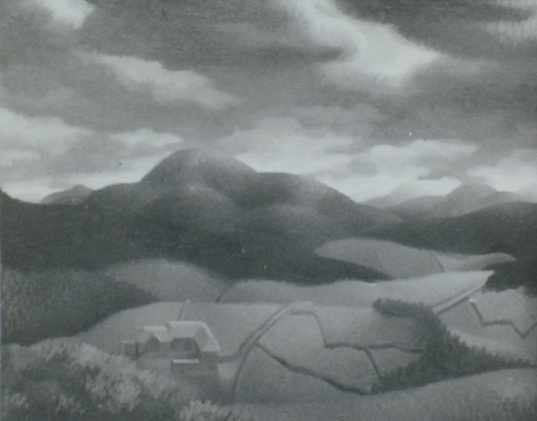
Exhibited :
Aberdeen and N.E. Artists Exhibition - 1940/1
R.B.A. - 1942/3
U.S.A. Tour - 1943
W.I.A.C. - 1944
Aberdeen and N.E. Artists Exhibition - 1940/1
R.B.A. - 1942/3
U.S.A. Tour - 1943
W.I.A.C. - 1944
Buchan Coast - 1940
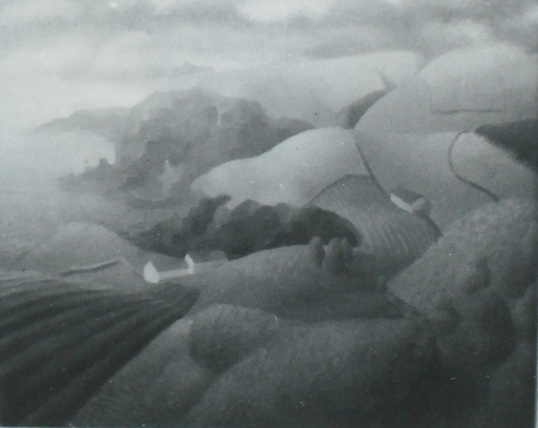
Exhibited :
Aberdeen and North East Artists - 1940/1
Aberdeen and North East Artists - 1940/1
Title unknown
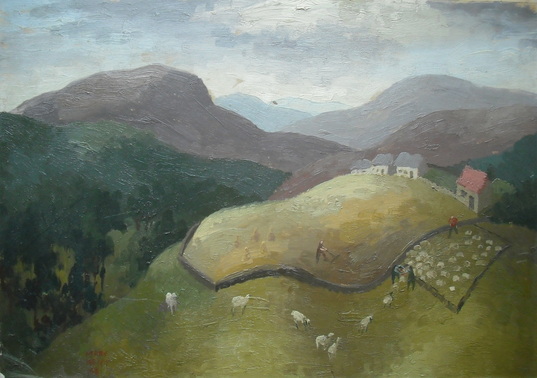
Dig For Victory - 1941 - Mary Kent Harrison
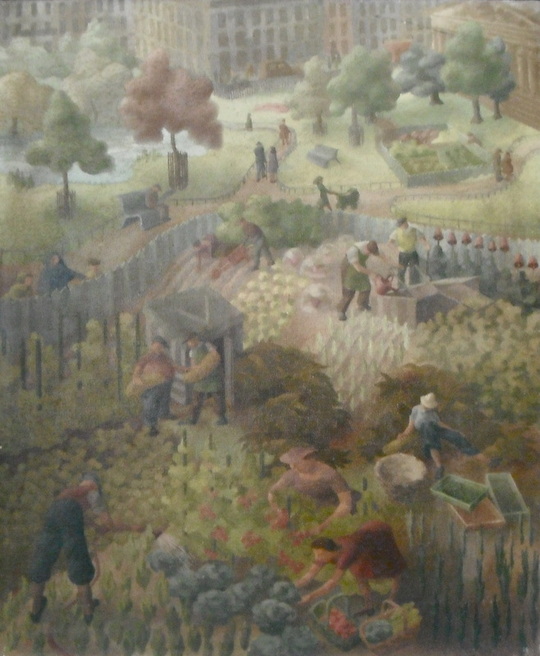
Dig For Victory - 1941 - Mary Kent Harrison
A month after the outbreak of the Second World war, The Ministry of Agriculture launched the slogan 'Dig For Victory'. Throughout the country, and for the benefit of the war effort gardens, allotments and public parks were put to the use as areas for growing vegetables. By 1943 over a million tons of vegetables were grown this way each year. The scene depicted looks like an area of a London park being used for the 'Dig For Victory' campaign. In 1942 Mary exhibited this painting called 'Dig For Victory" at the N.E.A.C. The same year, artist Adrian Allinson, an official War Artist painted a picture titled 'Dig For Victory' depicting St James Square being 'dug for victory'.
MKH's painting is, apart from anything else, of significant historical interest, and along with several others painted by her during the war, for example 'Victory Day, Richmond' could easily be exhibited alongside many works by the official War Artists.
During the second world war the War Artists' Advisory Committee (WAAC) was set up by the government and artists were recruited as there was considered a need to develop 'what the camera cannot interpret'. Of the selected artists, only a handful were women and amongst those, the works created by Dame Laura Knight, Evelyn Dunbar and Doris Zinkeisen would be works amongst which MKH's wartime paintings could have contributed considerably to the overall impression portrayed of Britain at war, both at home and abroad. It is a pity perhaps that she had not been chosen as a Official War Artist. She was certainly good enough to have been one.
This painting has been included in a book called 'George Orwell - English Rebel' by Robert Colls. Oxford University Press. Published 24th October 2013. It is Plate 16 in the publication.
If anyone can identify the location of the place that was the inspiration for this terrific painting, do please get in touch.
Dig For Victory - preparatory sketch, 1941
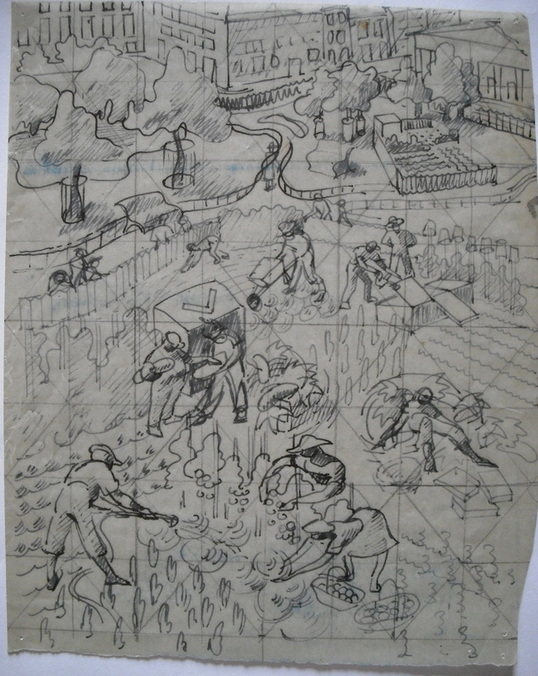
in 1941/2 Mary Kent Harrison was stationed in Bath and employed during this part of the war by Ordinance Survey, working on map production for the War Effort. Her husband, Kent, was a surgeon in the Royal Army Medical Corps and stationed mainly in the Middle East during the war (North Africa, Tobruk, El Alamein, Libya and the siege of Malta). He commanded a forward surgical unit at the Battle Of Alamein and ended up as a lieutenant colonel in command of a surgical division of a general hospital. After the war he continued his association with the Army and often, after a full week at St Thomas's Hospital, London, spent his Saturdays continuing his surgical work for the Army at the Aldershot Military Hospital. In due course there would be the expense of the upbringing of seven children to pay for, and so his hours were very long indeed. From 1952 he was consultant thoracic surgeon to the Royal Navy and Royal Army Medical Corps. He also taught and evenings at home were often spent marking exam papers.
'Dig For Victory' gives a valuable vision of how urban scenery was transformed and put to use during the war.
'Dig For Victory' gives a valuable vision of how urban scenery was transformed and put to use during the war.
Below is a wonderful photograph of G.Kent Harrison, RAMC in Cairo, 1942 at around the same time that MKH painted 'Dig For Victory'.
.
Aberdeen Fishwives c1942
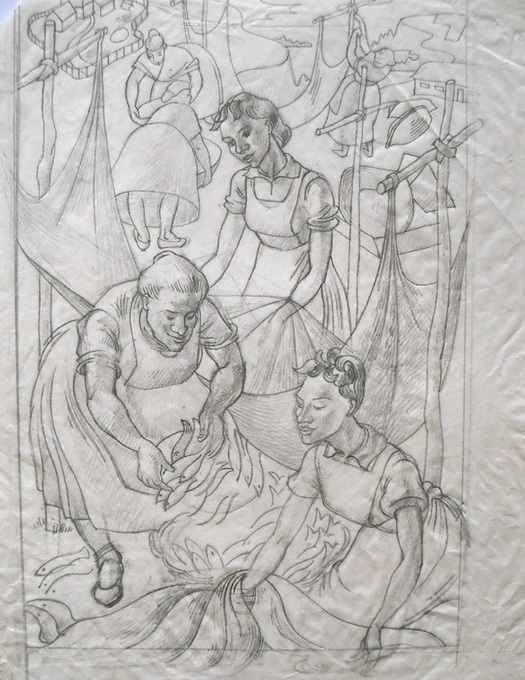
Aberdeen Fishwives - c1942
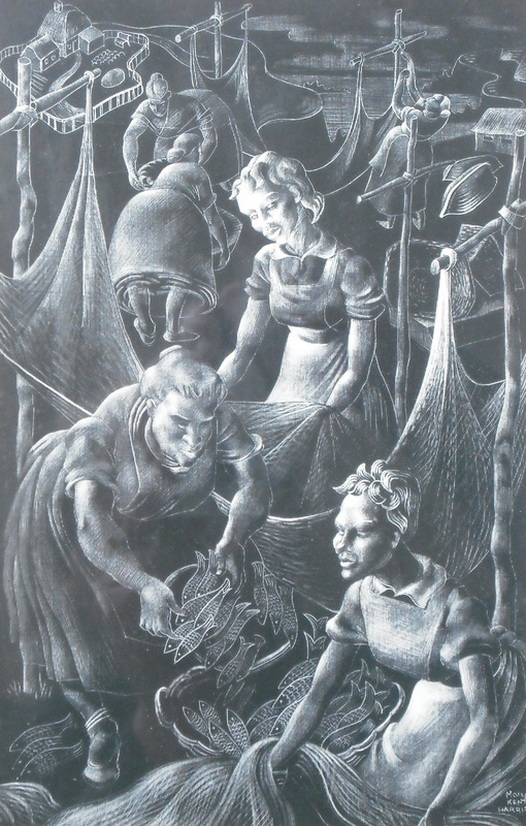
Preparatory drawing for unknown painting
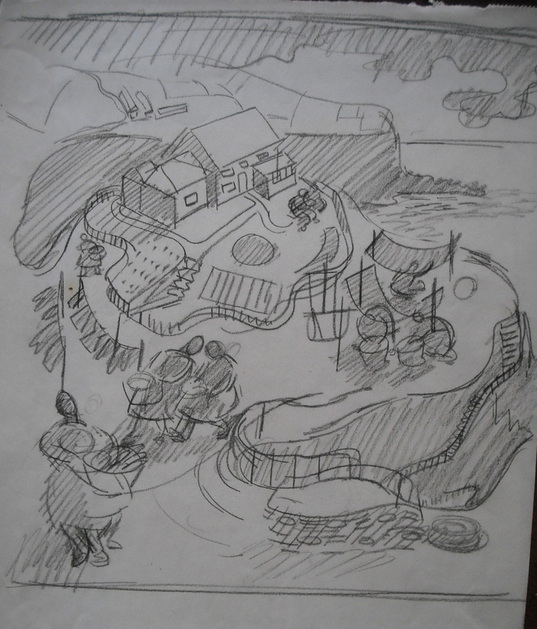
House By The River - 1943
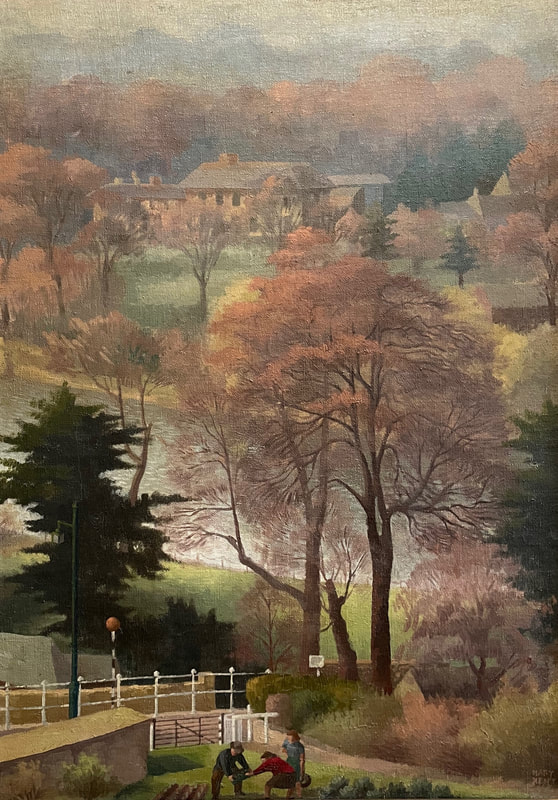
Mary Kent Harrison - 'House by the river' - 1943.
Exhibited :
R.A. - 1943
U.S.A. Tour 1944
Artist Aid To China Exhibition - 1944
Mary Kent Harrison - Varnishing Day - The Royal Academy 1943
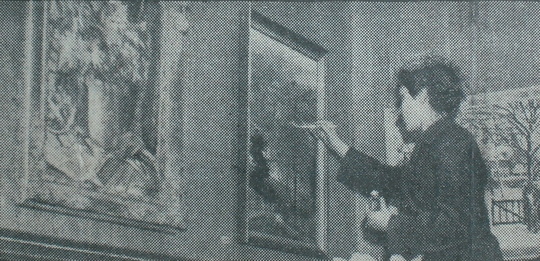
A photo published in an unidentified newspaper of Mary varnishing her painting 'House By The River' at The Royal Academy exhibition, May 1943. Quite unusual to see a painter actually varnishing a painting on varnishing day, but presumably there was a time when this was normal practise. I like to think it would have been an enjoyable activity, and one where she would have enjoyed the company of her contemporaries.
Pastel sketches
MKH often worked in pastels as a media. These are early examples and she developed her skills with this difficult medium as her career developed. She often used coloured paper when working with pastels and gouache paint.
Death Of A Tree - 1944 - Mary Kent Harrison
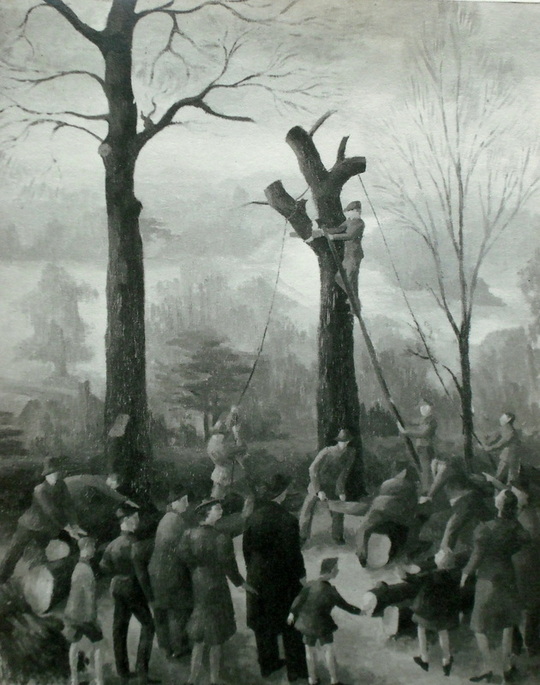
There are two versions of this composition, small and large, and it is not currently known which one this is. Both were painted in 1944 and both exhibited at The Leicester Galleries, London, in 1944. Mary often did a small and large version of a chosen subject. The river in the background is The Thames, at Richmond, London and the viewpoint is from The Terrace, Richmond.
Preparatory drawing for 'Death Of A Tree'
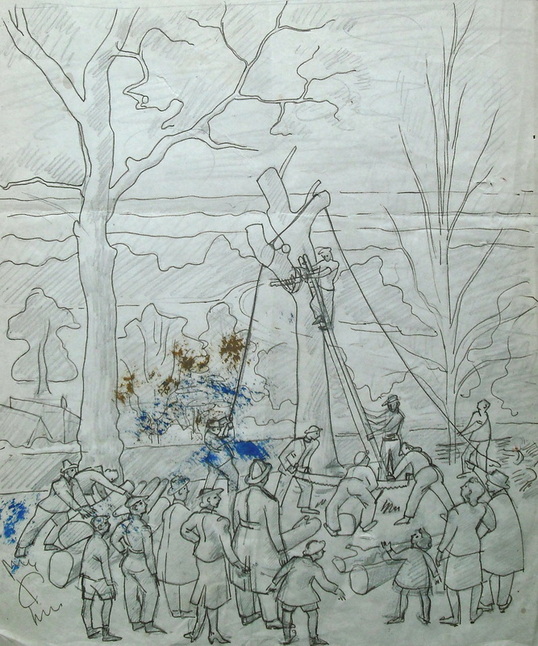
Victory Day, Richmond Hill - Mary Kent Harrison - 1945. Also known as V.E. Day, Richmond Hill.
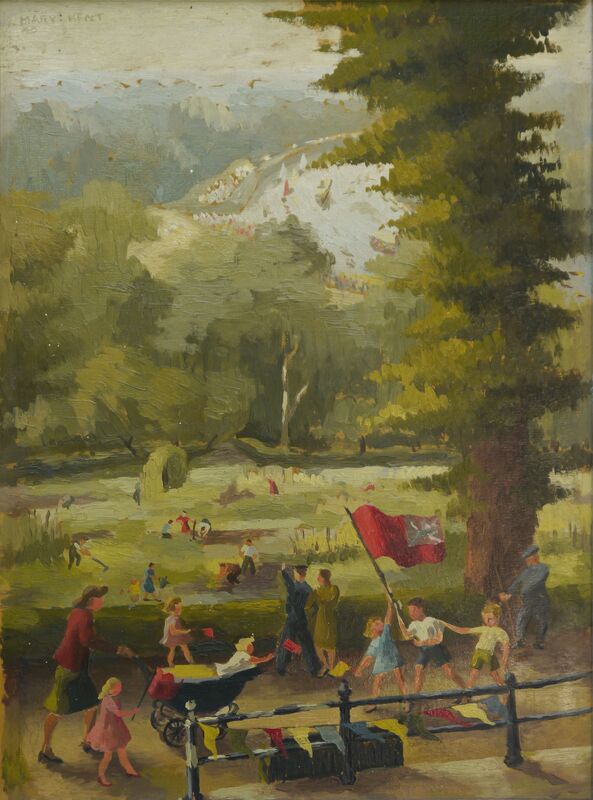
Victory Day, Richmond Hill - Mary Kent Harrison - 1945. Also known as V.E. Day, Richmond Hill.
Victory Day, Richmond. Oil on canvas, 1945. Also known as V.E. Day, Richmond. (Victory in Europe).
The painting was exhibited at R.B.A and Leicester Galleries in 1945, the Cambridge Drawing Society, 1950, Gallery One, Settle, 1972, Australian Tour, 1979 and Gawthorpe Hall, 1980.
In MKH's record book she notes it as 'V.E. Day, Richmond (small)'.
There is also a larger version of this subject. See next image. This smaller painting was included as an illustration in George Orwell's book 'The English People' 1947 published by Collins, London. According to records, this painting was held in Mary's possession throughout her life, and finally sold at her posthumous exhibition at The King Street Galleries in 1983.
MKH was fortunate to have spent many years of her childhood living in a wonderful house on The Terrace, Richmond. Her father Howard bought a house there in the 1920's and she lived there until her marriage in 1939. The renowned view looking west over the Thames features in several of MKH's paintings. JMW Turner also painted the view in the 1830's. It is believed to be the ony view in England protected by an Act Of Parliament and is still, to this day a remarkably beautiful view.
The painting was exhibited at R.B.A and Leicester Galleries in 1945, the Cambridge Drawing Society, 1950, Gallery One, Settle, 1972, Australian Tour, 1979 and Gawthorpe Hall, 1980.
In MKH's record book she notes it as 'V.E. Day, Richmond (small)'.
There is also a larger version of this subject. See next image. This smaller painting was included as an illustration in George Orwell's book 'The English People' 1947 published by Collins, London. According to records, this painting was held in Mary's possession throughout her life, and finally sold at her posthumous exhibition at The King Street Galleries in 1983.
MKH was fortunate to have spent many years of her childhood living in a wonderful house on The Terrace, Richmond. Her father Howard bought a house there in the 1920's and she lived there until her marriage in 1939. The renowned view looking west over the Thames features in several of MKH's paintings. JMW Turner also painted the view in the 1830's. It is believed to be the ony view in England protected by an Act Of Parliament and is still, to this day a remarkably beautiful view.
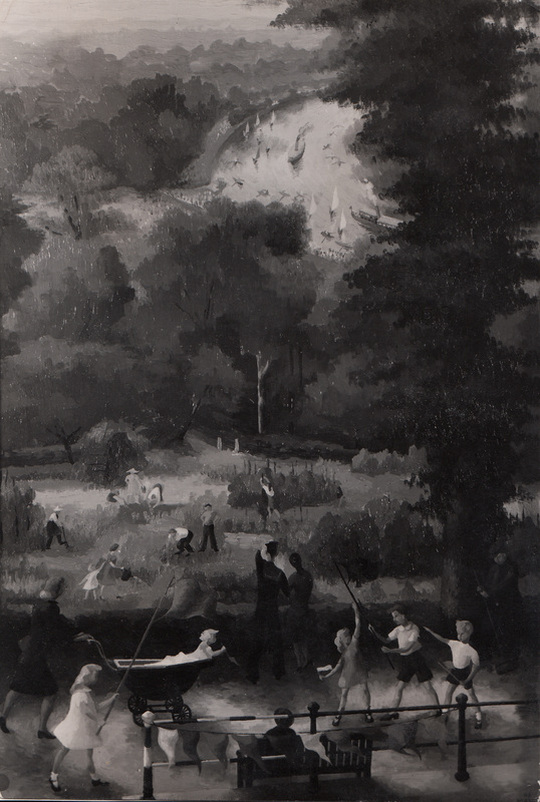
V Day, Richmond - Mary Kent Harrison - 1945.
Mary Kent Harrison
This is another (larger) version of the subject.
Exhibited Richmond Arts Council, 1945?, R.B.A. and N.E.A.C 1945. Sold at the NEAC 1945.
On the label on the back of the painting it is titled 'V. Day, Richmond' though in MKH's record book she notes it as 'V.E. Day, Richmond (big)'.
Published in 'The Studio', February 1948 where it was one of several images accompanying an article on Mary written by Michael Ayrton.
There are many differences, some subtle in the composition of the two paintings.
This view of Richmond is the renowned view from The Terrace, looking down on The Thames. This view appears in many of her paintings at this period.
This painting has been included in a book called 'George Orwell - English Rebel' by Robert Colls. Oxford University Press. Published 24th October 2013. It is Plate 17 in the publication.
Exhibited Richmond Arts Council, 1945?, R.B.A. and N.E.A.C 1945. Sold at the NEAC 1945.
On the label on the back of the painting it is titled 'V. Day, Richmond' though in MKH's record book she notes it as 'V.E. Day, Richmond (big)'.
Published in 'The Studio', February 1948 where it was one of several images accompanying an article on Mary written by Michael Ayrton.
There are many differences, some subtle in the composition of the two paintings.
This view of Richmond is the renowned view from The Terrace, looking down on The Thames. This view appears in many of her paintings at this period.
This painting has been included in a book called 'George Orwell - English Rebel' by Robert Colls. Oxford University Press. Published 24th October 2013. It is Plate 17 in the publication.
Preparatory drawing for Victory Day -1945
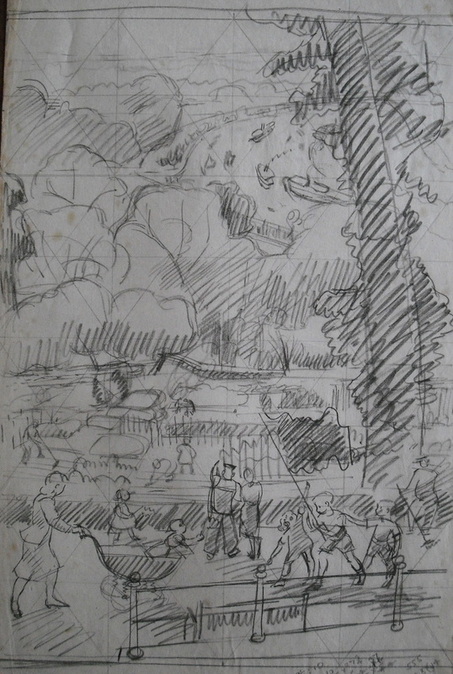
Sketch for Victory Day
Highland Fishing Village - 1940
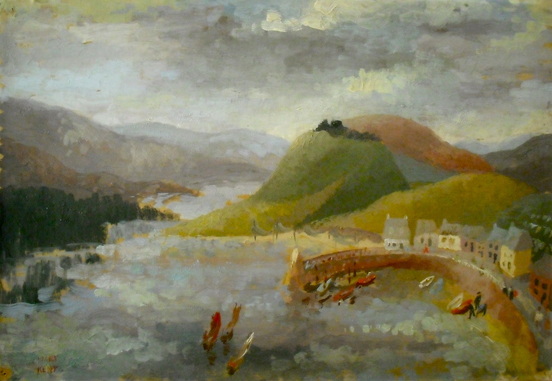
Mary and Kent loved Scotland, particularly the West Coast. The record book Mary made of her paintings reveals evidence that there were many trips to Scotland throughout her life. In the early days of their marriage, they travelled there on Kent's motor bike and sidecar. They enjoyed exploring and were great walkers. This oil painting on board was possibly done from sketches made on one of their trips there.
Exhibited :
Leicester Galleries 1949
Cambridge Drawing Society 1950
R.B.A. 1953
R.B.A. 1954
Exhibited :
Leicester Galleries 1949
Cambridge Drawing Society 1950
R.B.A. 1953
R.B.A. 1954
Sketch for 'Spring In The Square' - 1940
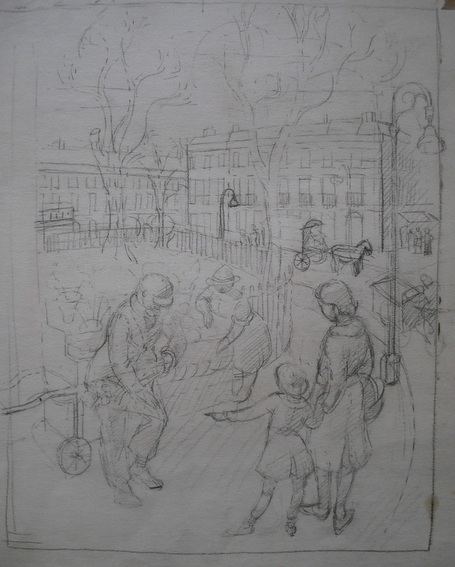
Spring In The Square (small) - 1940
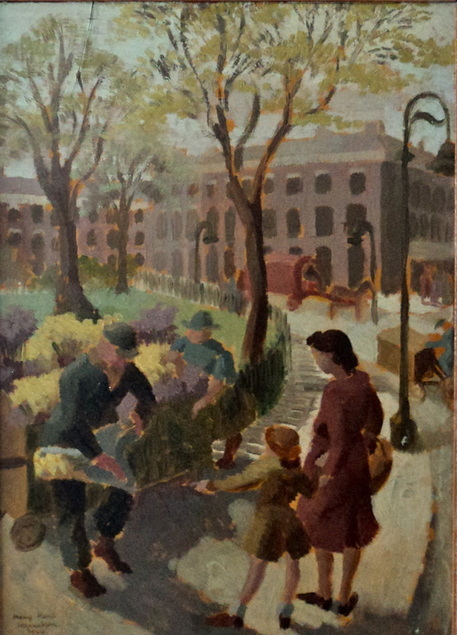
Signed Mary Kent Harrison.
Soon after her marriage in August 1939, but still not at the time of this painting, Mary signed her work Mary Kent, and continued to do this for the rest of her life.
The location depicted is Mecklenburgh Square in London. This may be an oil sketch probably on board that has been primed in yellow ochre, which is visible here and there. The mother and child are thinking about buying flowers. Painted during the war, here is a brief moment of pleasure, far from the front, and where the sun still shines.
A larger version of this subject matter was also painted. See next image. Either this painting, or the next one, was included in Mary's exhibition at The Brook Street Galleries in London in 1940.
The series of views of Mecklenburgh Square remind one of times spent 'looking out of the window' at the immediate life going by outside, and MKH surely enjoyed witnessing such life and including it in her subject matter.
Exhibited :
Aberdeen and North English Artists, 1940
R.S.A. 1941
Bath Society Of Artists, 1942
Soon after her marriage in August 1939, but still not at the time of this painting, Mary signed her work Mary Kent, and continued to do this for the rest of her life.
The location depicted is Mecklenburgh Square in London. This may be an oil sketch probably on board that has been primed in yellow ochre, which is visible here and there. The mother and child are thinking about buying flowers. Painted during the war, here is a brief moment of pleasure, far from the front, and where the sun still shines.
A larger version of this subject matter was also painted. See next image. Either this painting, or the next one, was included in Mary's exhibition at The Brook Street Galleries in London in 1940.
The series of views of Mecklenburgh Square remind one of times spent 'looking out of the window' at the immediate life going by outside, and MKH surely enjoyed witnessing such life and including it in her subject matter.
Exhibited :
Aberdeen and North English Artists, 1940
R.S.A. 1941
Bath Society Of Artists, 1942
Spring On The Square (large) 1940
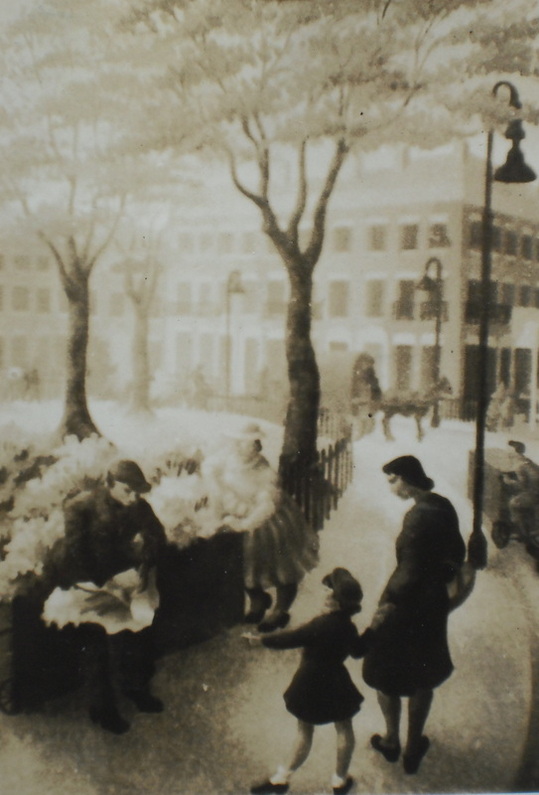
Snow On The Square (small) - 1941
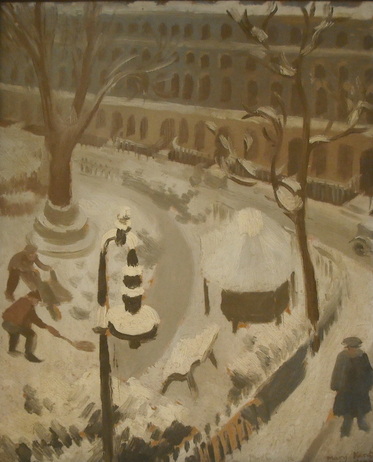
Mary Kent Harrison - 'Snow on the Square- 1941
Exhibited : Bath Society Of Artists 1942.
Leicester Galleriers and R.O.I. 1943.
W.I.A.C. 1945.
Cambridge Drawing Society 1948.
A label on the back describes the location as Mecklenburgh Square, London and the composition seems to have been made looking down from an upper floor window. Painted on board primed with yellow ochre it appears to have been done very quickly perhaps as a sketch for a later painting. The previous image, 'Spring In The Square' would seem to be of the same location. Mecklenburgh Square was Mary and Kent's first marital home together, and Kent kept this painting on the wall above his desk throughout his retirement years. As is often the case with first homes, perhaps there were strong feelings and memories associated with their home at Mecklenburgh Square, and this is likely to have been the view from their window. A letter to MKH dated 2nd February 1940 confirms Mecklenburgh Square as her residence at the time of her one woman exhibition at the Brook Street Galleries, London in February/March 1940. However, when her husband was stationed overseas during the war, MKH returned to her parents house at The Terrace, Richmond. It seems that it was not until after the war ended that the young family could set up home properly together, and when they did so, it was to be in Cambridge.
Leicester Galleriers and R.O.I. 1943.
W.I.A.C. 1945.
Cambridge Drawing Society 1948.
A label on the back describes the location as Mecklenburgh Square, London and the composition seems to have been made looking down from an upper floor window. Painted on board primed with yellow ochre it appears to have been done very quickly perhaps as a sketch for a later painting. The previous image, 'Spring In The Square' would seem to be of the same location. Mecklenburgh Square was Mary and Kent's first marital home together, and Kent kept this painting on the wall above his desk throughout his retirement years. As is often the case with first homes, perhaps there were strong feelings and memories associated with their home at Mecklenburgh Square, and this is likely to have been the view from their window. A letter to MKH dated 2nd February 1940 confirms Mecklenburgh Square as her residence at the time of her one woman exhibition at the Brook Street Galleries, London in February/March 1940. However, when her husband was stationed overseas during the war, MKH returned to her parents house at The Terrace, Richmond. It seems that it was not until after the war ended that the young family could set up home properly together, and when they did so, it was to be in Cambridge.
Beech wood - 1941
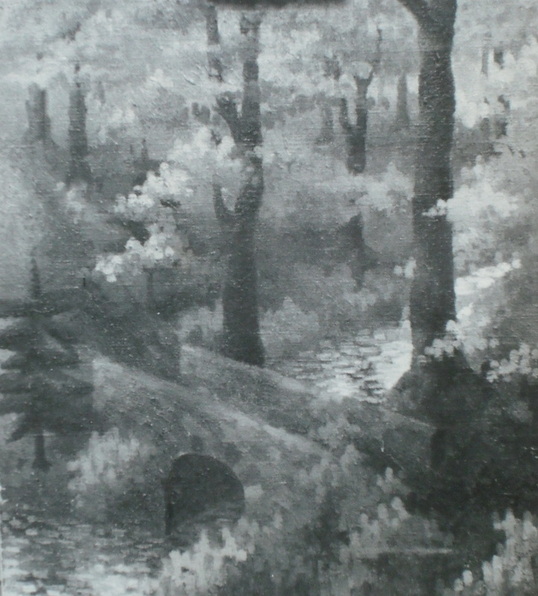
Ireland - late 1930's or early 1940's (title to be confirmed)
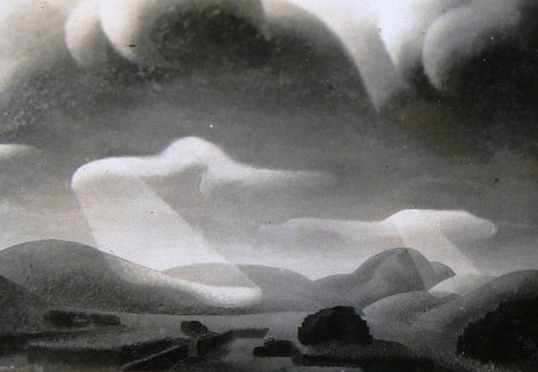
An early landscape. Date unknown. A painting titled Ireland was included in Mary's exhibition at The Brook Street Galleries in 1940. This image has been cropped and therefore the whole composition is not shown.
Preparatory sketch
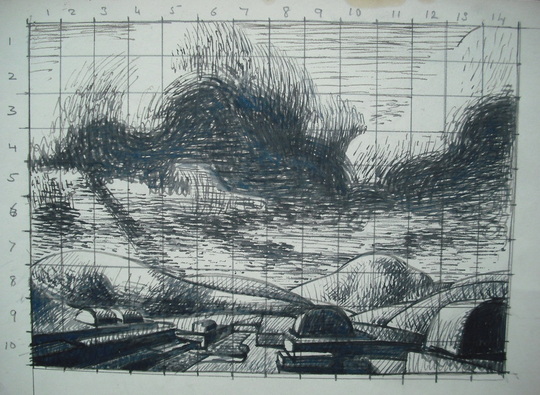
El Alamein - 1942
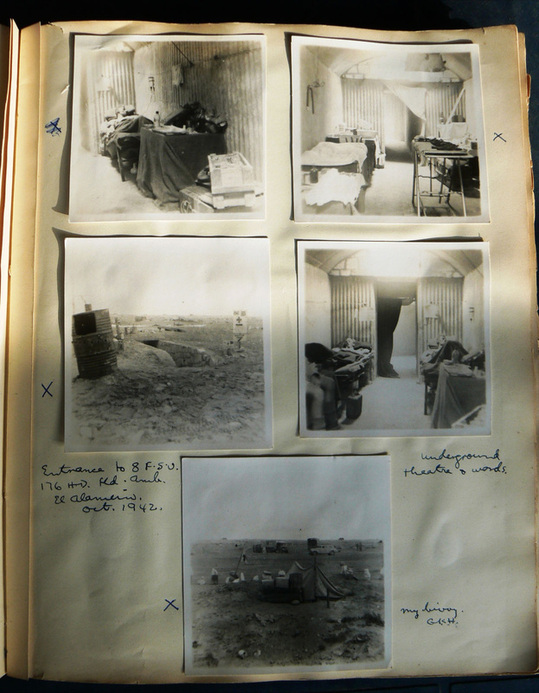
Marys husband, Kent, commanded a forward surgical unit at the Battle Of Alamein in 1942. He had his camera with him and these, and other images are from his collection of fascinating photographs he took during his military service. The above images are of a temporary underground hospital in the desert. He seldom talked about his experiences during the war, or the effect it had on had on him and one can respect his decision not to do so, whatever the reason.
Kent had a keen interest in photography all his life and was very good at it. He developed and printed his own photographs. He was able to use the darkroom facilities at St Thomas's Hospital for that purpose, the same darkroom that was used for the processing of Xray images presumably. He had several Leica cameras, and his preferred camera was a Rolleiflex. It was his photographs that contributed greatly to the remarkably extensive family albums and record books that MKH created for each of the seven children as we grew up. It was also very often Kent who photographed MKH's finished paintings.
Stopping to take photographs was a pleasure he indulged in often whilst on holidays. He also enjoyed using a Bolex 35mm cine camera. Many family home movies were made, and also movies during his holidays with Mary later in Spain. His photography (the above 'documentary' examples are not fully representative) is evidence that the beauty of the natural world was something that they shared. Amongst other of Kent's other interests were classical music, opera, fishing, current affairs and politics.
Kent had a keen interest in photography all his life and was very good at it. He developed and printed his own photographs. He was able to use the darkroom facilities at St Thomas's Hospital for that purpose, the same darkroom that was used for the processing of Xray images presumably. He had several Leica cameras, and his preferred camera was a Rolleiflex. It was his photographs that contributed greatly to the remarkably extensive family albums and record books that MKH created for each of the seven children as we grew up. It was also very often Kent who photographed MKH's finished paintings.
Stopping to take photographs was a pleasure he indulged in often whilst on holidays. He also enjoyed using a Bolex 35mm cine camera. Many family home movies were made, and also movies during his holidays with Mary later in Spain. His photography (the above 'documentary' examples are not fully representative) is evidence that the beauty of the natural world was something that they shared. Amongst other of Kent's other interests were classical music, opera, fishing, current affairs and politics.
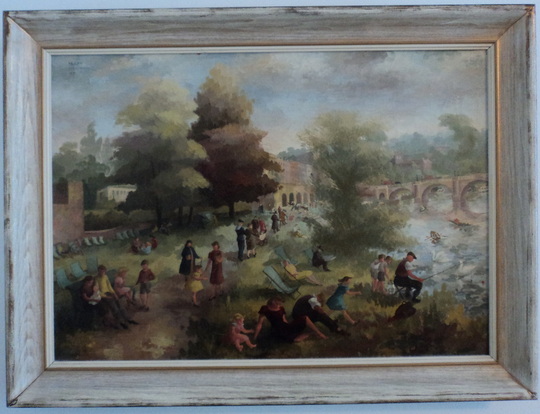
Richmond Bridge - 1940's - Mary Kent Harrison
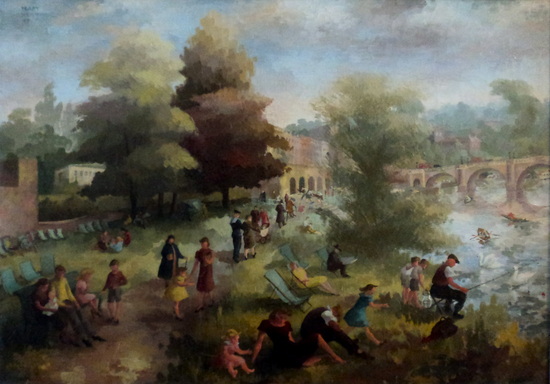
Richmond Bridge - 1940's - Mary Kent Harrison
In this wonderful painting, what is perhaps most striking, apart from the beauty of colour and composition, is the number of people portrayed. This is slightly reminiscent of L.S.Lowry, (1887-1976) whose paintings, although very different in style, were often populated with people from the world he knew. In this painting Mary has painted people in her contemporary world, Richmond in London, in the 1940's. In the many scenes depicted in this painting, the balance of the solitary and the accompanied is weighted in favour of the latter.
MKH would have spent time imagining each scenario, and made many studies in preparation for this painting. It is possible that this was painted at around the same time as Victory Day, Richmond. By and large, there is a feeling of ease and pleasure as her people rejoice in their freedom, similar to the joy communicated in Victory Day. There is an important note that contradicts this and it is found in the group of three in the foreground where the woman's attention appears to be distracted form the infant by her side, and the man sitting next to her, presumably her partner, is clearly in deep melancholia. His back is arched, his head bent down and he stares at the ground, lost in introspection and a grief the cause of which is left to the viewers imagination. Alongside him and in contrast to his mood, a girl merrily runs towards the river. Nearby a solitary man is fishing in this busy environment hardly conducive to such activity. Two children to his left are probably disturbing his peace, taking delight in or perhaps teasing the two swans they are watching in the river where three boats progress to or from the bridge over which several vehicles are crossing.
Behind the man fishing are three deckchairs possibly hired for a penny or two from a municipal storeroom nearby. The beautifully painted and nearest of these chairs is vacant, a lovely touch. In the second, a solitary woman in a bright yellow dress relaxes with arms folded and head tilted to one side perhaps in sleep. In the third and in contrast sits a darkly dressed gentleman wearing a black hat who appears to be sketching. Behind all these figures runs the path along the river.
Sitting on the bench in the foreground a young couple with a tiny infant. An older child sits alongside and another hovers on the path, one hand idly toying with the arm of the bench as he converses with the girl in pink. Next a mother appears to be instructing her child. Near her a mysterious figure in black leaning on a walking stick, stationary and solitary.
Leading up the pathway and enjoying their gentle walk we see another couple. He wears a naval uniform and she pushes a pram. Maybe he is on leave from his duties in the Navy and enjoying every precious moment he can with his beloved and their new child. The progression continues with another couple and then an older solitary and sombre gentleman with a walking stick and wearing a long black coat.
On the left of the picture the line of vacant deckchairs hug the wall and take the eye past a group enjoying a picnic on the grass. We are led to the shaded area under the trees where yet another group can just be made out enjoying each others company in the privacy of the shade that they prefer.
Finally, on the steps leading up from the river to the secretive dark arches of the building at the side of the path, we see a group of three or so children racing up the steps with the vibrant energy of youth.
The pathway, the wall and the river lead the eye into the picture. The angles of these elements and the line of the bridge create the sense of perspective and the focal point subtly placed to the right of centre. The space is also communicated by the use of colour. In the foreground are the warm tones of the grass and gravel of the pathway and also the hot colours of the limbs and some of the clothing of the group of three there. In the far distance the soft blue colder tones of the trees at the horizon. All this is carefully put to work. Thus the scene is set for the panoply and colour of life Mary has chosen to portray.
It would seem that this is a painting of harmony in a beautiful place where the young and the old, the solitary and the accompanied, the frenzied and the fatigued are enjoying a warm summers day by the river. And yet the melancholy of the man in the foreground and the depiction of another in navy uniform are keys to a different interpretation, whereby the harmony and sense of ease have come at a terrible price. The price of war.
MKH would have spent time imagining each scenario, and made many studies in preparation for this painting. It is possible that this was painted at around the same time as Victory Day, Richmond. By and large, there is a feeling of ease and pleasure as her people rejoice in their freedom, similar to the joy communicated in Victory Day. There is an important note that contradicts this and it is found in the group of three in the foreground where the woman's attention appears to be distracted form the infant by her side, and the man sitting next to her, presumably her partner, is clearly in deep melancholia. His back is arched, his head bent down and he stares at the ground, lost in introspection and a grief the cause of which is left to the viewers imagination. Alongside him and in contrast to his mood, a girl merrily runs towards the river. Nearby a solitary man is fishing in this busy environment hardly conducive to such activity. Two children to his left are probably disturbing his peace, taking delight in or perhaps teasing the two swans they are watching in the river where three boats progress to or from the bridge over which several vehicles are crossing.
Behind the man fishing are three deckchairs possibly hired for a penny or two from a municipal storeroom nearby. The beautifully painted and nearest of these chairs is vacant, a lovely touch. In the second, a solitary woman in a bright yellow dress relaxes with arms folded and head tilted to one side perhaps in sleep. In the third and in contrast sits a darkly dressed gentleman wearing a black hat who appears to be sketching. Behind all these figures runs the path along the river.
Sitting on the bench in the foreground a young couple with a tiny infant. An older child sits alongside and another hovers on the path, one hand idly toying with the arm of the bench as he converses with the girl in pink. Next a mother appears to be instructing her child. Near her a mysterious figure in black leaning on a walking stick, stationary and solitary.
Leading up the pathway and enjoying their gentle walk we see another couple. He wears a naval uniform and she pushes a pram. Maybe he is on leave from his duties in the Navy and enjoying every precious moment he can with his beloved and their new child. The progression continues with another couple and then an older solitary and sombre gentleman with a walking stick and wearing a long black coat.
On the left of the picture the line of vacant deckchairs hug the wall and take the eye past a group enjoying a picnic on the grass. We are led to the shaded area under the trees where yet another group can just be made out enjoying each others company in the privacy of the shade that they prefer.
Finally, on the steps leading up from the river to the secretive dark arches of the building at the side of the path, we see a group of three or so children racing up the steps with the vibrant energy of youth.
The pathway, the wall and the river lead the eye into the picture. The angles of these elements and the line of the bridge create the sense of perspective and the focal point subtly placed to the right of centre. The space is also communicated by the use of colour. In the foreground are the warm tones of the grass and gravel of the pathway and also the hot colours of the limbs and some of the clothing of the group of three there. In the far distance the soft blue colder tones of the trees at the horizon. All this is carefully put to work. Thus the scene is set for the panoply and colour of life Mary has chosen to portray.
It would seem that this is a painting of harmony in a beautiful place where the young and the old, the solitary and the accompanied, the frenzied and the fatigued are enjoying a warm summers day by the river. And yet the melancholy of the man in the foreground and the depiction of another in navy uniform are keys to a different interpretation, whereby the harmony and sense of ease have come at a terrible price. The price of war.
Kent Harrison in military service in the Western Desert, 1942
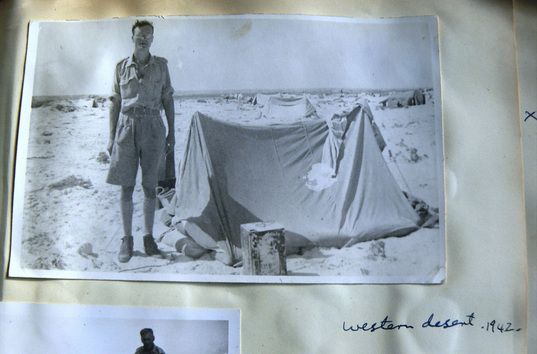
Nut Gatherers - Richmond Park - 1946 - Mary Kent Harrison
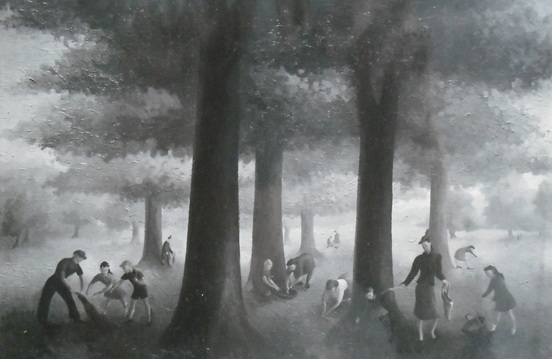
Nut Gatherers - Richmond Park - 1946 - Mary Kent Harrison
Exhibited - R.B.A, 1947.
W.I.A.C, 1947
A smaller version of this subject also exists and was sold at the Leicester Galleries in 1946. The activity of gathering nuts in Richmond Park has historical interest, and it still takes place though it is preferred that the nuts are left on the ground for the deer, who benefit from feeding on them! In the year it was painted, rationing of food would have still been in place, and so free foods of any kind would have been most valuable and would not have been allowed to go to waste.
The depiction of the figures has great charm and balance. Their movement and energy contrasting well with the sombre solidity and rhythm of the substantial dark trunks of the trees. The nearest of these is the darkest and clearest, and as the trees recede into the distance, they are depicted in gradually lighter tones, thus helping to create the illusion of space.
W.I.A.C, 1947
A smaller version of this subject also exists and was sold at the Leicester Galleries in 1946. The activity of gathering nuts in Richmond Park has historical interest, and it still takes place though it is preferred that the nuts are left on the ground for the deer, who benefit from feeding on them! In the year it was painted, rationing of food would have still been in place, and so free foods of any kind would have been most valuable and would not have been allowed to go to waste.
The depiction of the figures has great charm and balance. Their movement and energy contrasting well with the sombre solidity and rhythm of the substantial dark trunks of the trees. The nearest of these is the darkest and clearest, and as the trees recede into the distance, they are depicted in gradually lighter tones, thus helping to create the illusion of space.
Nut Gatherers, Richmond Park (sketch) - 1946
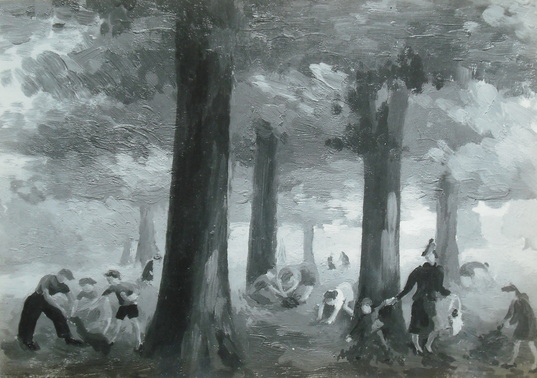
Border Land - 1942 (title to be confirmed)
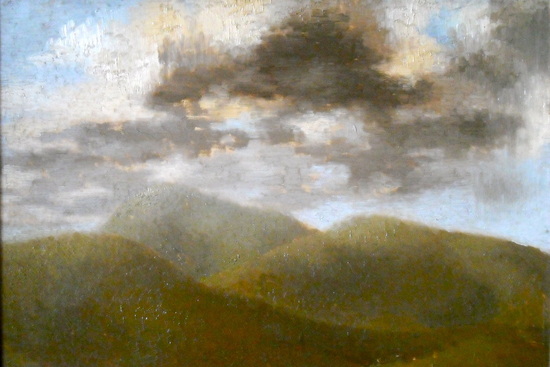
A relatively simple composition of hillside and clouds. Unusually devoid of the human form, this sensual portrayal of landscape is typical of her work during the 1940's.
Exhibited :
R.A. 1945
Eastbourne, 1945
W.I.A.C. 1946
R.B.A 1948
Exhibited :
R.A. 1945
Eastbourne, 1945
W.I.A.C. 1946
R.B.A 1948
Sheep Shearers - 1946
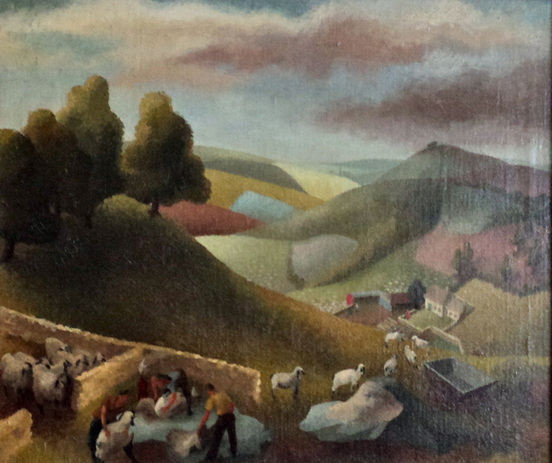
Exhibited : W.I.A.C. 1947
The simplified shapes of the hills and trees recalls the work of both John Nash (1893-1977) and Paul Nash (1889 -1946), who may have been an influence on MKH's work. The rolling hills recede into the distance and the different colours and exaggerated shapes of the fields help define their form. Here we see a somewhat idealized vision. Humankind at one with nature in a rural idyl and land of plenty where the men are at work in a sunlit landscape beautifully tamed and manicured and where there are cosy farmhouses fitting snugly into the hillside to return to at the end of the day. The slightly surreal and deeply felt vision and the stylized manner in which it is expressed here has very great charm and interest.
The depiction of the hills in this and the previous image (Border Land) is reminiscent of the painting by Paul Nash (1889-1946) entitled 'Wood On The Downs'. The work of Eric Ravilious (1903-1942) also comes to mind.
The simplified shapes of the hills and trees recalls the work of both John Nash (1893-1977) and Paul Nash (1889 -1946), who may have been an influence on MKH's work. The rolling hills recede into the distance and the different colours and exaggerated shapes of the fields help define their form. Here we see a somewhat idealized vision. Humankind at one with nature in a rural idyl and land of plenty where the men are at work in a sunlit landscape beautifully tamed and manicured and where there are cosy farmhouses fitting snugly into the hillside to return to at the end of the day. The slightly surreal and deeply felt vision and the stylized manner in which it is expressed here has very great charm and interest.
The depiction of the hills in this and the previous image (Border Land) is reminiscent of the painting by Paul Nash (1889-1946) entitled 'Wood On The Downs'. The work of Eric Ravilious (1903-1942) also comes to mind.
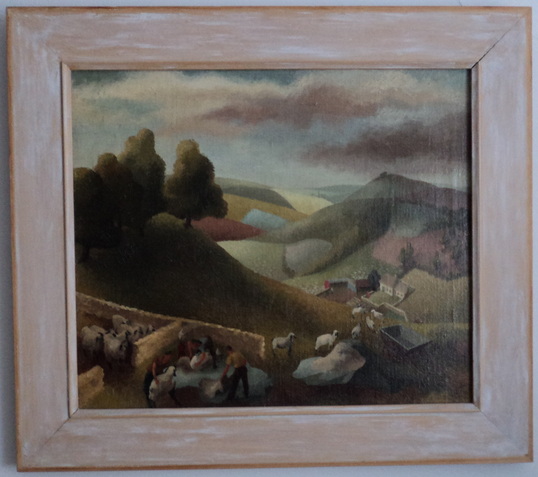
Whitsunday, Twickenham - 1945
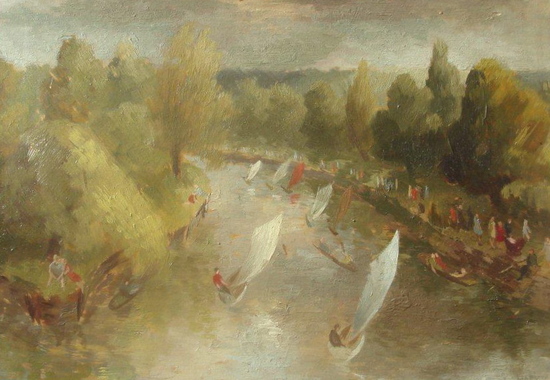
Exhibited :
Richmond Arts Council. 1945.
Leicester Galleries, 1947.
R.B.A 1950.
Cambridge Drawing Society 1951.
St Thomas's Hospital, London, 1953.
R.B.A 1953.
N.E.A.C 1958.
A tangible sense of movement is conveyed by the sails of the boats coming towards the viewer with the character of their form a result of the influence of the pleasant summer breeze. Dated 1945, perhaps this was just after the end of the war, hence the sense of pleasure, relief and free time.
Richmond Arts Council. 1945.
Leicester Galleries, 1947.
R.B.A 1950.
Cambridge Drawing Society 1951.
St Thomas's Hospital, London, 1953.
R.B.A 1953.
N.E.A.C 1958.
A tangible sense of movement is conveyed by the sails of the boats coming towards the viewer with the character of their form a result of the influence of the pleasant summer breeze. Dated 1945, perhaps this was just after the end of the war, hence the sense of pleasure, relief and free time.
Almonds, Richmond (study)
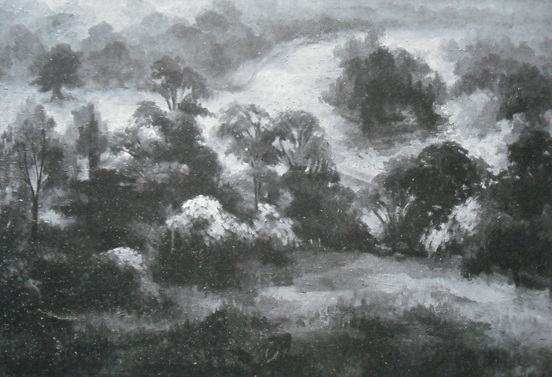
Almonds, Richmond
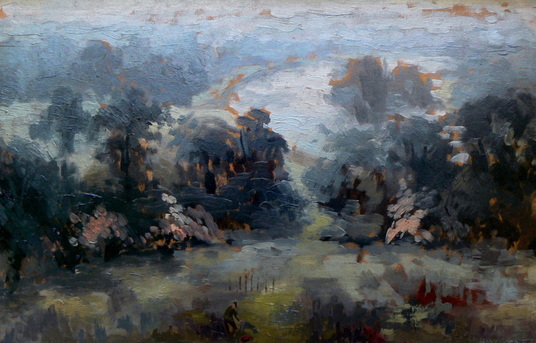
The bend in the river Thames at Richmond which MKH painted so often.
Mary Kent Harrison - Nativity - 1946
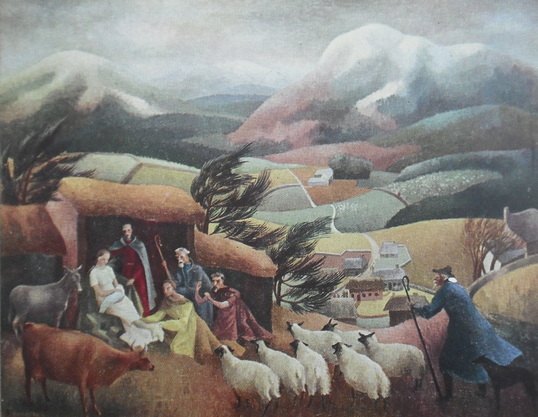
Mary Kent Harrison - Nativity - 1946
Exhibited :
Leger Galleries, 13 Old Bond Street, London. 1945 - 'Religious Paintings And Drawings'
N.E.A.C. 1946.
Published in 'The Studio' -May 1946, page 159.
The Nativity imagined in a British landscape. This is perhaps her only painting with a religious theme that is communicated in a such a direct way, and this may be because although her faith and belief in her religion were central and held throughout her life, she held that faith quietly, never seeking, apart perhaps by example, to 'convert' others. She supported the local church wherever she lived, taking part in services and contributing time to church activities. She once went as far as to reveal that she felt sorry for those who were without faith and in the light of that, one can hope and imagine that her faith was a great source of strength and comfort to her throughout her life.
Finding great beauty in it all, she was perhaps able to give herself up by submitting to ideas she felt were far greater than her own could ever be, and the fact that the religious story could not be explained or justified to some in cold hard logic only served to strengthen her faith. It was as if in the conscious act of believing what seems to many to be unbelievable she was able to sacrifice her self, transcend the logical and mundane and find meaning to life - and the end of life.
The writer takes the view that the scientific explanation of creation, existence and consciousness, the unraveling of which humankind seems unable to resist will, in its own way, be no less and may possibly prove even more problematic and difficult to believe, if that is possible.
Preparatory study for 'Nativity'
Border Land - 1945 (title to be confirmed)
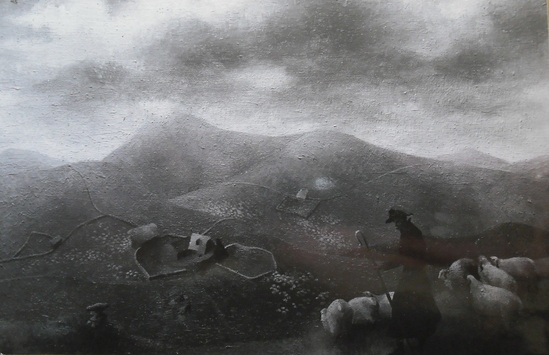
A lonely and bleak atmosphere to this. The shepherd and his flock of sheep in a desolate place but in sight of home.
Exhibited :
R.A. - 1945
W.I.A.C. - 1946
R.B.A. - 1948
Exhibited :
R.A. - 1945
W.I.A.C. - 1946
R.B.A. - 1948
The Farm - 1940
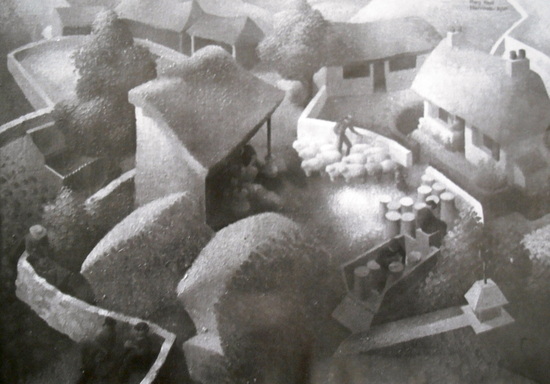
One of several early 'fantastic' scenes, possibly based on sketches made near Purbeck, Dorset, around 1947. Shapes have been simplified and abstracted in this swirling vortex of a composition. Tremendous rhythm is created by the cascading line, curves and shapes of the roof tops and walls. A farm steading has been depicted. Sheep are being sheared and milk churns unloaded from a cart. Two people are sitting behind a wall having a break or skiving from all the work going on at the farm. The slightly surreal 'toy farm' feel to this is perhaps partly due to the curious use of scale in the depiction of the farmhouse to the right. It seems impossibly small, reminiscent perhaps of J.R.R. Tolkein's fictional Hobiton.
There is a feeling of 'looking down from above' to this painting, and this characteristic can often be found in her landscape paintings.
Exhibited :
Brook Street Galleries - 1940
There is a feeling of 'looking down from above' to this painting, and this characteristic can often be found in her landscape paintings.
Exhibited :
Brook Street Galleries - 1940
Study drawing for The Farm
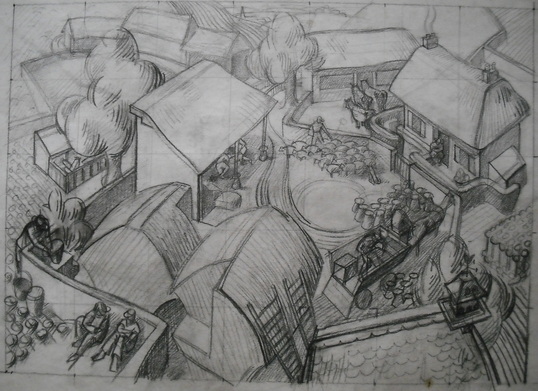
An earlier study drawing for 'The Farm"
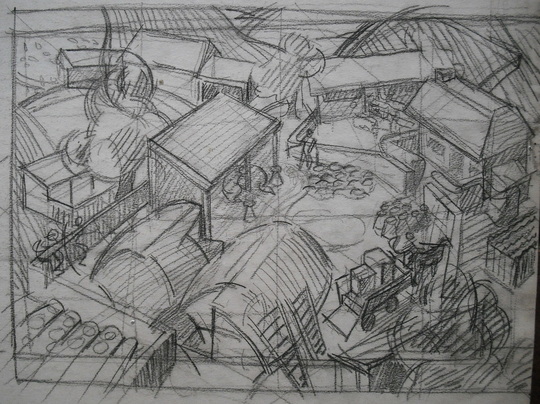
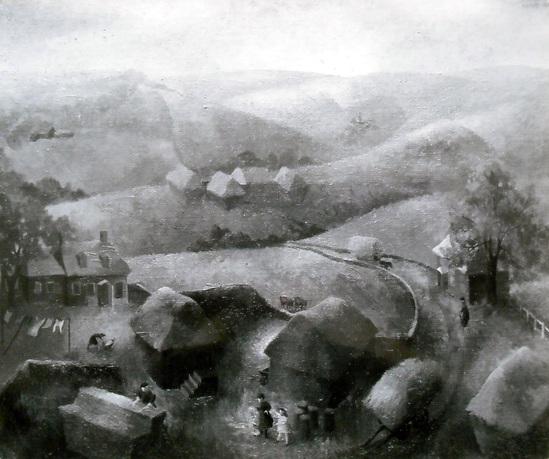
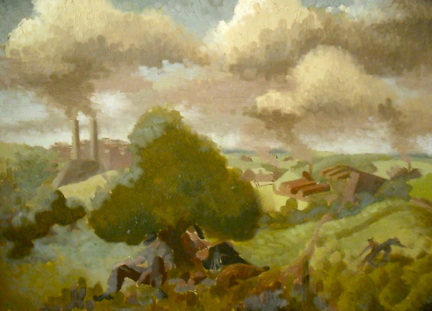
Unusual in that industrial buildings are incorporated into the landscape. There appears to be a city in the distance, and the factories with their tall smoking chimneys seem to have been dropped into the green fields which remain impossibly fresh and unspoilt around them. The figures in the foreground are resting under a tree, whilst two others are harvesting in the field. The depiction of both work and rest from work in the same painting is a motif often used.
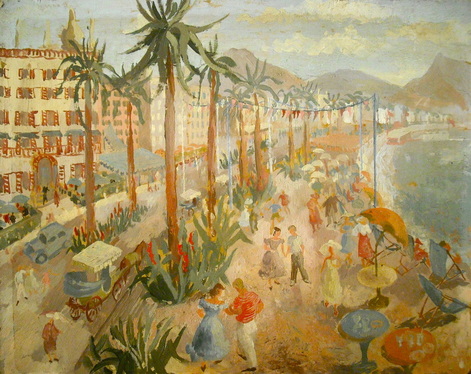
Oil sketch on board. Possibly south coast of France.
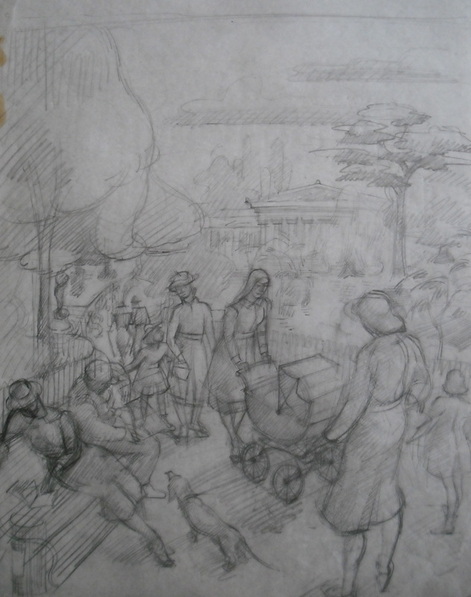
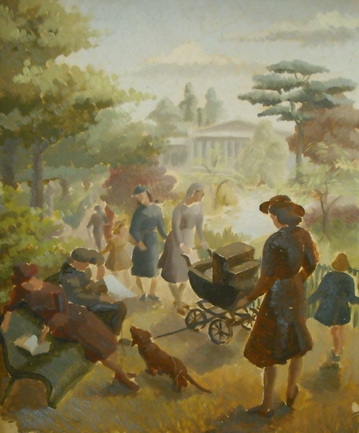
Oil sketch on board.
Kew Gardens - Fantasy - 1950
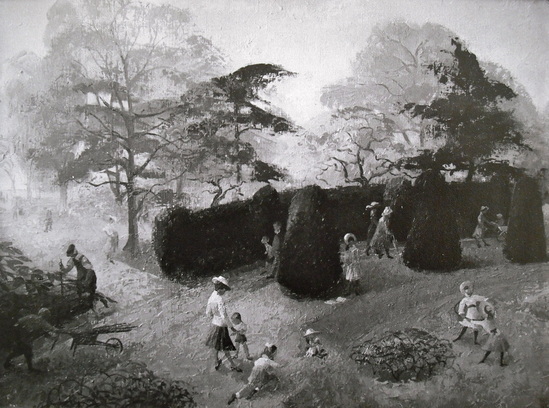
Mary Kent Harrison - Kew Gardens - Fantasy - 1950
Still in the post war years of rationing (until as late as 1954 for some foods) and painted a year before the 1951 Festival Of Britain such anxiety free scenes of relaxation and joy would hardly be the norm. Despite all, the children delight in their games, the spirit of young life unbroken by hardship.
It could be argued that fantasy is a characteristic of her work, particularly the early work. Very often, MKH presents an idealized world of harmony often between human kind and nature. In many paintings it appears 'fantastic' and abstracted, and she admits to the fantasy by incorporating the word in the title for this painting. For the realist, such harmony could seem contentious, and that view could certainly be sincerely held. The analyst, on the other hand, might argue that fantasy is just as real or relevant, if not more real than 'reality'. Both reactions, in that they exist, confirm that the expression of fantasy must at the very least be worthy of interest. Such interest is abundant in Mary's work.
It could be argued that fantasy is a characteristic of her work, particularly the early work. Very often, MKH presents an idealized world of harmony often between human kind and nature. In many paintings it appears 'fantastic' and abstracted, and she admits to the fantasy by incorporating the word in the title for this painting. For the realist, such harmony could seem contentious, and that view could certainly be sincerely held. The analyst, on the other hand, might argue that fantasy is just as real or relevant, if not more real than 'reality'. Both reactions, in that they exist, confirm that the expression of fantasy must at the very least be worthy of interest. Such interest is abundant in Mary's work.
Mary Kent Harrison painting - 1950
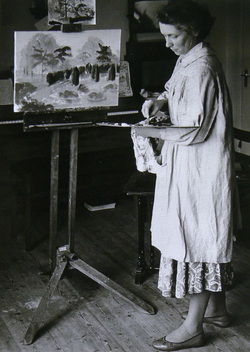
A photograph of the above painting in progress. A small sketch is attached to the easle above the the main canvas. This would probably have been done at Kew gardens, the final painting being created at home. There is little foreground area depicted in the sketch and at the stage that the photograph was taken, it seems MKH was still at an early stage of composing the scene depicted in the foreground of the final painting. Most of the flowerbeds would eventually go, creating space for the figures.
Kew Gardens, Easter. 1946
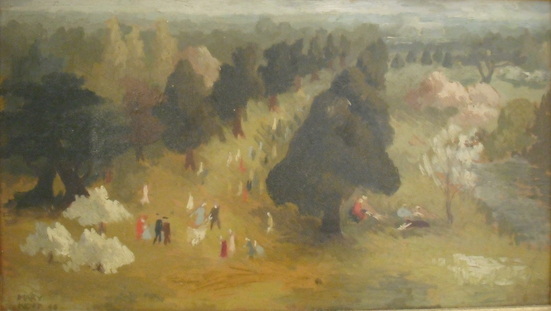
Exhibited :
W.I.A.C. 1947
Town Hall Richmond, 1947
Cambridge Drawing Society 1949
N.E.A.C. 1951
R.B.A. 1953
Gallery One, Settle, 1972
W.I.A.C. 1947
Town Hall Richmond, 1947
Cambridge Drawing Society 1949
N.E.A.C. 1951
R.B.A. 1953
Gallery One, Settle, 1972
Thawscape - 1945
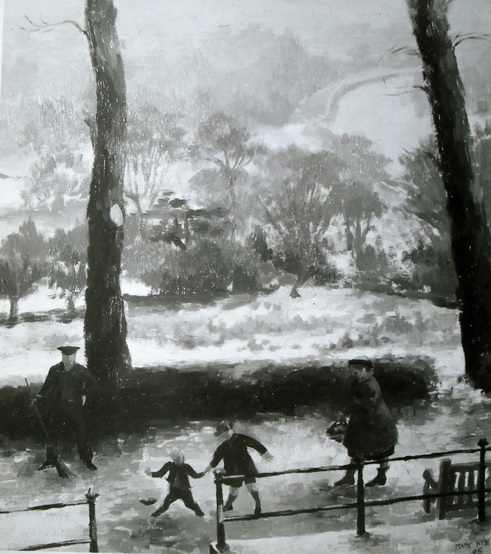
Exhibited :
Royal Academy, 1945.
W.I.A.C. 1946.
Painted from the same vantage point as V.E. Day, Richmond. Likely to have been painted a matter of weeks before the cessation of war in Europe on 8th May, 1945.
Royal Academy, 1945.
W.I.A.C. 1946.
Painted from the same vantage point as V.E. Day, Richmond. Likely to have been painted a matter of weeks before the cessation of war in Europe on 8th May, 1945.
March, Kew Gardens - 1955 - Mary Kent Harrison
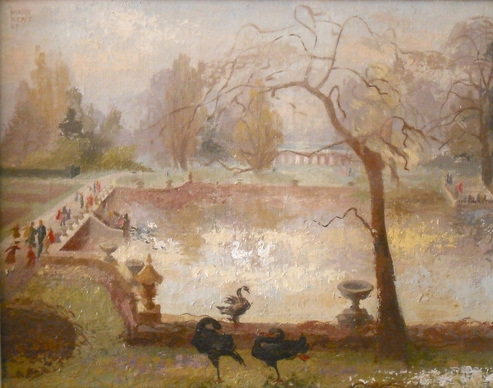
March, Kew Gardens - 1955 - Mary Kent Harrison
Exhibited :
R.B.A. 1956
King Street Galleries, Knutsford,1979
Gawthorpe Hall, 1980.
Exhibited :
R.B.A. 1956
King Street Galleries, Knutsford,1979
Gawthorpe Hall, 1980.
The birds in the foreground take centre stage, their one legged preening providing entertainment. Meanwhile people hurriedly cross the bridge on this chilly March day.
The formal elements of balustrade and bridge define the space, allowing for the delicate expression in soft pastel colours of the water and wintry trees.
R.B.A. 1956
King Street Galleries, Knutsford,1979
Gawthorpe Hall, 1980.
The birds in the foreground take centre stage, their one legged preening providing entertainment. Meanwhile people hurriedly cross the bridge on this chilly March day.
The formal elements of balustrade and bridge define the space, allowing for the delicate expression in soft pastel colours of the water and wintry trees.
Marble Hill, May. 1959/60.
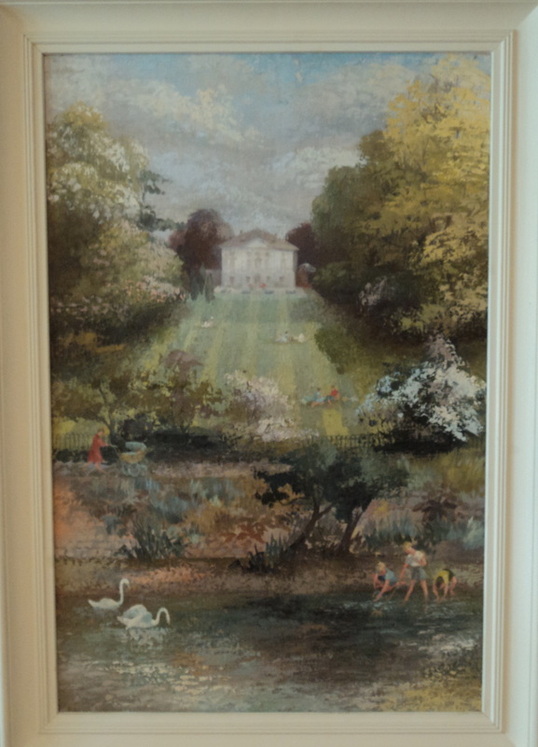
Exhibited :
N.E.A.C 1963.
R.B.A. 1964.
Gallery One, Settle, 1972.
N.E.A.C 1963.
R.B.A. 1964.
Gallery One, Settle, 1972.
November, Twickenham Ferry - 1959/60
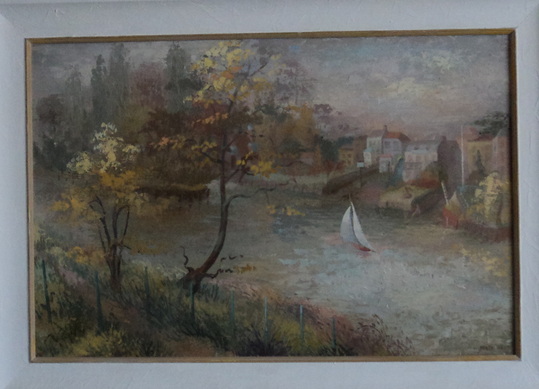
Exhibited :
R.B.A. 1963.
N.E.A.C.(Brighton) 1963.
Bladen Gallery 1964
N.E.A.C. 1965
Unusual in that the composition is devoid of the human figure. The quiet solitude and subtle colour of this late autumn day by the river is beautifully communicated. The tree seems humanized as it reaches out, bending over the river. Its curved trunk answering the curve of the sails on the boat. The moment is anchored by the firm vertical of the building at the right of the composition and the reliable repetition of the fence posts along the pathway.
R.B.A. 1963.
N.E.A.C.(Brighton) 1963.
Bladen Gallery 1964
N.E.A.C. 1965
Unusual in that the composition is devoid of the human figure. The quiet solitude and subtle colour of this late autumn day by the river is beautifully communicated. The tree seems humanized as it reaches out, bending over the river. Its curved trunk answering the curve of the sails on the boat. The moment is anchored by the firm vertical of the building at the right of the composition and the reliable repetition of the fence posts along the pathway.
The Cam - 1951
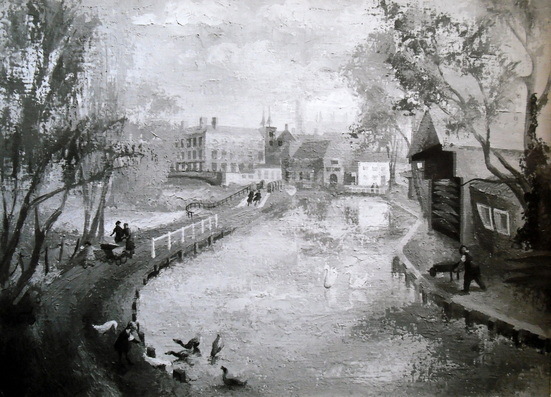
The Cam - 1951 - Mary Kent Harrison
Cambridge Lace - 1952 - Mary Kent Harrison
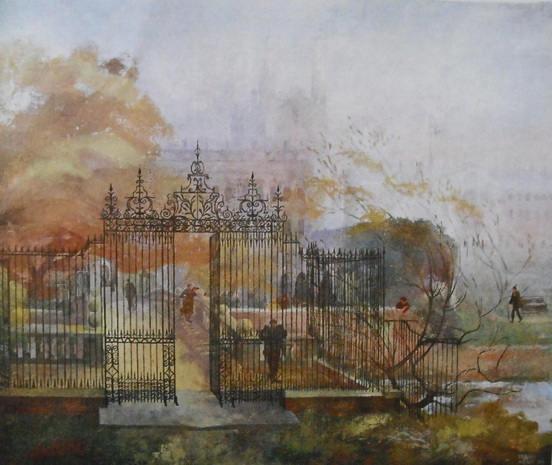
Cambridge Lace - 1952 - Mary Kent Harrison
Oil on canvas. Exhibited :
R.B.A. 1953,
N.E.A.C. 1955.
R.A. 1958.
Published in 'The Studio', June, 1954, page 187. This image was photographed from a copy of that publication and so a very great deal of detail, particularly in the background is likely to be missing from this terrific painting.
Sold to London Historical Museum, Ontario, Canada, 1958, and still in their collection.
R.B.A. 1953,
N.E.A.C. 1955.
R.A. 1958.
Published in 'The Studio', June, 1954, page 187. This image was photographed from a copy of that publication and so a very great deal of detail, particularly in the background is likely to be missing from this terrific painting.
Sold to London Historical Museum, Ontario, Canada, 1958, and still in their collection.
Cambridge - 1951 - Mary Kent Harrison
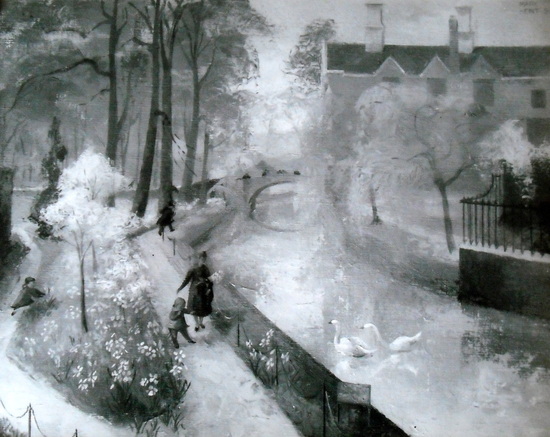
Cambridge - 1951 - Mary Kent Harrison
Daffodils, Cambridge - 1948 - Mary Kent Harrison
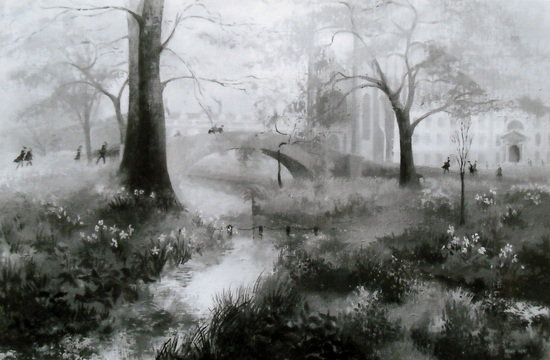
Daffodils, Cambridge - 1948 - Mary Kent Harrison
Exhibited :
R.B.A. 1951
Not long after the war, Mary and Kent went to live in Cambridge. Kent spent four years there (1947-1952) as consultant thoracic surgeon to Papworth and Addenbrooke's Hospitals. After that he was a thoracic and cardiothoracic surgeon from 1952-1973 at St Thomas' Hospital London, and also surgeon in charge of the Casualty Department there from 1966 - 1973. He was also consultant surgeon to the Royal Navy 1952-1972 and Surgical Specialist RAMC 1952-1973. He was an Examiner in Surgery at London University. He retired in 1973 as Honorary Consultant Cardiothoracic Surgeon at St Thomas' Hospital, London.
Mary painted many pictures of Cambridge during those years, of which this is an example. She particularly enjoyed incorporating the river Cam, as it wound it's way through the university grounds. The paintings are a wonderful, atmospheric record of Cambridge at the time.
R.B.A. 1951
Not long after the war, Mary and Kent went to live in Cambridge. Kent spent four years there (1947-1952) as consultant thoracic surgeon to Papworth and Addenbrooke's Hospitals. After that he was a thoracic and cardiothoracic surgeon from 1952-1973 at St Thomas' Hospital London, and also surgeon in charge of the Casualty Department there from 1966 - 1973. He was also consultant surgeon to the Royal Navy 1952-1972 and Surgical Specialist RAMC 1952-1973. He was an Examiner in Surgery at London University. He retired in 1973 as Honorary Consultant Cardiothoracic Surgeon at St Thomas' Hospital, London.
Mary painted many pictures of Cambridge during those years, of which this is an example. She particularly enjoyed incorporating the river Cam, as it wound it's way through the university grounds. The paintings are a wonderful, atmospheric record of Cambridge at the time.
Cambridge Backs - 1946 - Mary Kent Harrison
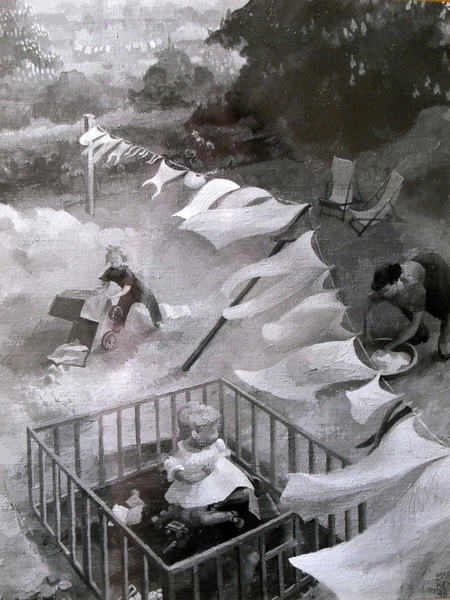
Cambridge Backs - 1946 - Mary Kent Harrison
Exhibited :
New English Art Club, 1946.
New English Art Club, 1946.
Kent and Mary, Cambridge, 1947
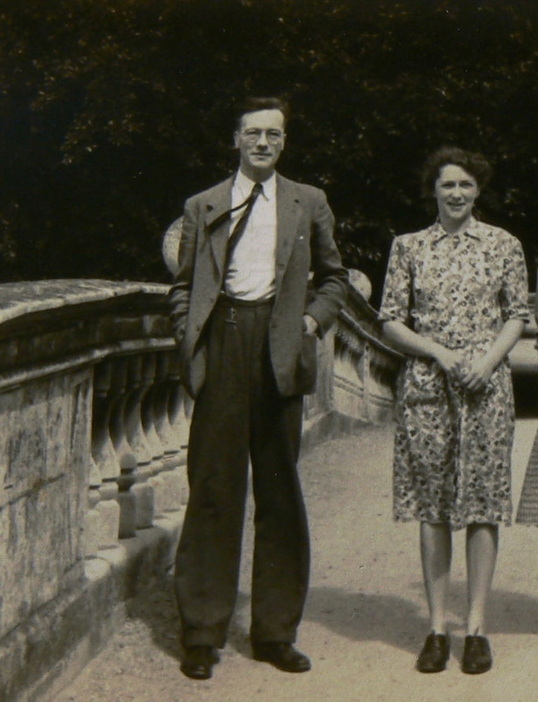
Mary Kent Harrison and George Kent Harrison - Cambridge - 1947
Kent and Mary in Cambridge, 1948
The Thames At Richmond - 1953
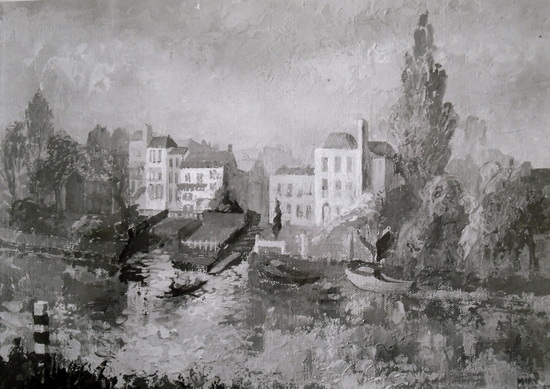
Winter Weekend, Richmond - 1954
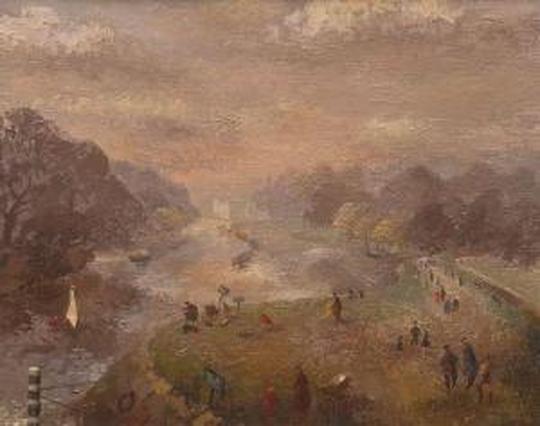
Mary Kent Harrison - Winter Weekend, Richmond - 1954
Exhibited:
R.B.A. 1954.
R.B.A. 1954.
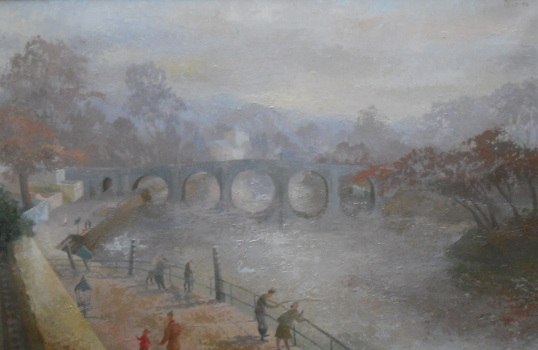
'November, Richmond Bridge' 1954 - Mary Kent Harrison.
Exhibited : RBA 1955. Brighton, 1955, NEAC 1956,
Such wistful, beautiful colours convey the soft mistiness of this autumn day by The Thames at Richmond.
November Fishers - 1957
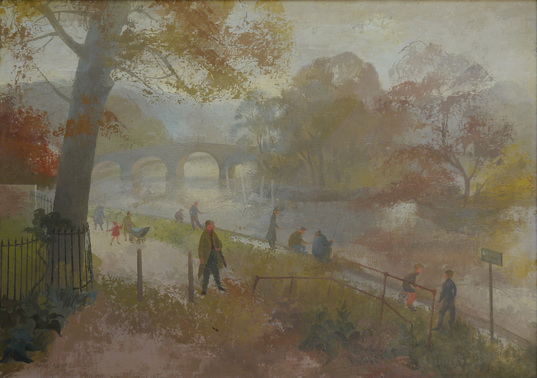 November Fishers - 1957 - Mary Kent Harrison (a view of The Thames at Ricmond)
November Fishers - 1957 - Mary Kent Harrison (a view of The Thames at Ricmond)
November Fishers - 1957 - Mary Kent Harrison
Exhibited :
Royal Academy - 1959
RBA - 1960
Gawthorpe Hall - 1980
Exhibited :
Royal Academy - 1959
RBA - 1960
Gawthorpe Hall - 1980
The Serpentine - 1950's
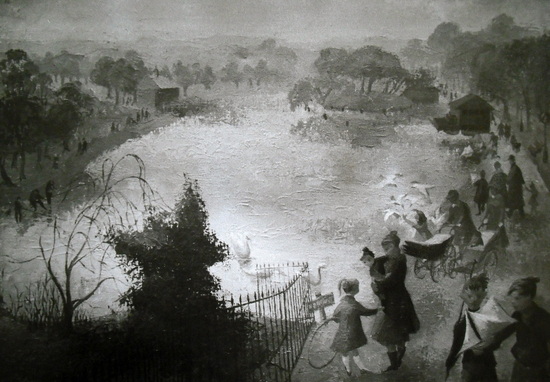
Richmond's River - 1966 - Mary Kent Harrison
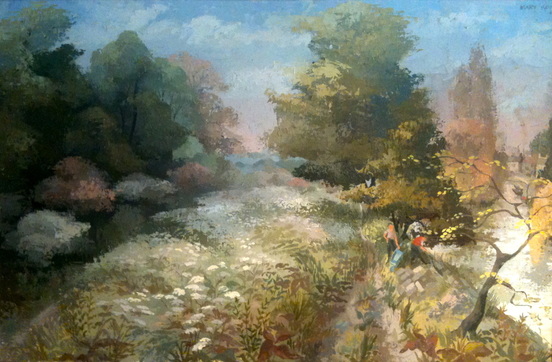
Richmond's River - 1966 - Mary Kent Harrison
Exhibited :
N.E.A.C, 1966
There is still a lovely walk along the river at Richmond, just down from The Terrace, but it is doubtful if it is ever as beautiful as this. It is high summer. Meadow flowers have been allowed to grow to their full glory and bring their wild freedom to this urban backwater.
Today we might call such spaces 'designated green environments' to be fenced off, out of bounds and venerated like caged animals on the verge of extinction. The patterns of the flowers and their leaves are expressed here with a light and free touch. If only one could walk into this paradise and sense the intoxicating scent of summer.
N.E.A.C, 1966
There is still a lovely walk along the river at Richmond, just down from The Terrace, but it is doubtful if it is ever as beautiful as this. It is high summer. Meadow flowers have been allowed to grow to their full glory and bring their wild freedom to this urban backwater.
Today we might call such spaces 'designated green environments' to be fenced off, out of bounds and venerated like caged animals on the verge of extinction. The patterns of the flowers and their leaves are expressed here with a light and free touch. If only one could walk into this paradise and sense the intoxicating scent of summer.
February, Richmond Bridge - 1966/7
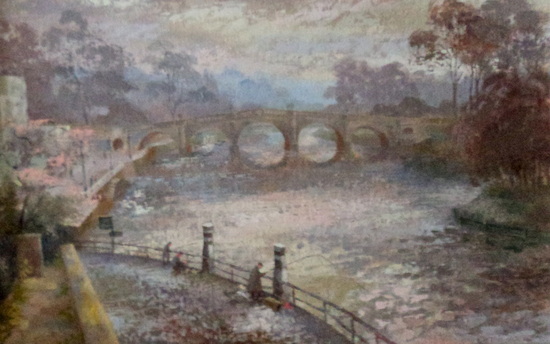
Exhibited :
R.B.A. 1974,
Gallery One, Settle, 1974
R.B.A. 1974,
Gallery One, Settle, 1974
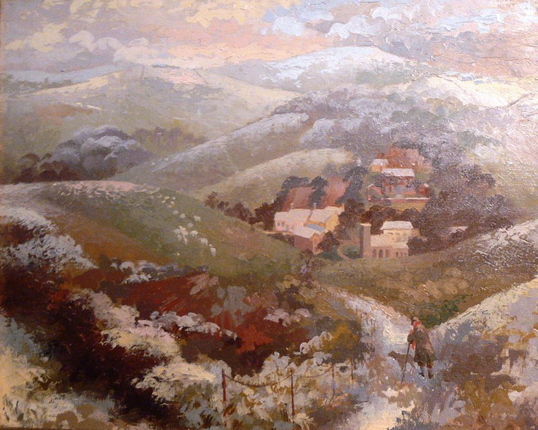
Knowlmere, Autumn - 1972
